STM32存储左右互搏 模拟U盘桥接SPI总线FATS读写FLASH W25QXX
STM32存储左右互搏 模拟U盘桥接SPI总线FATS读写FLASH W25QXX
STM32的USB接口可以模拟成为U盘,通过FATS文件系统对连接的存储单元进行U盘方式的读写。
这里介绍STM32CUBEIDE开发平台HAL库模拟U盘桥接SPI总线FATS读写W25Q各型号FLASH的例程。
FLASH是常用的一种非易失存储单元,W25QXX系列Flash有不同容量的型号,如W25Q64的容量为64Mbit,也就是8MByte。
W25QXX介绍
W25QXX的SOIC封装如下所示,在采用SPI而不是QUAL SPI时,管脚定义为:

即由片选(/CS), 时钟(CLK), 数据输出(DO)和数据输入(DI)的组成4线SPI信号接口。VCC和GND提供电源和接地连接。
例程采用STM32H750VBT6芯片, FLASH可以选择为8/16/32/64/128/256/512/1024 Mbit的W25Q型号。例程实现可以通过U盘形式和串口控制双方式对FLASH内的文件进行操作,实现可交换操作的特性。
STM32工程配置
首先建立基本工程并设置时钟:
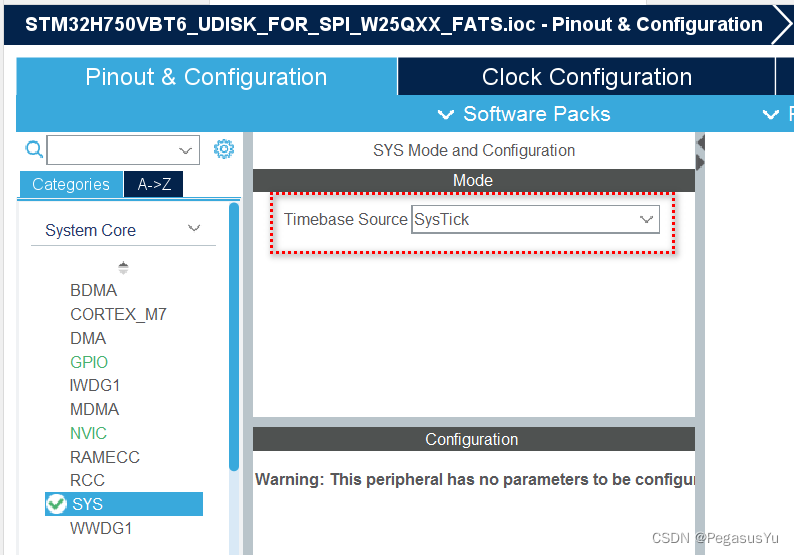
对于STM32H7,有专用的内部48MHz时钟用于USB接口, 其它应用采用内部高速时钟接口即可:
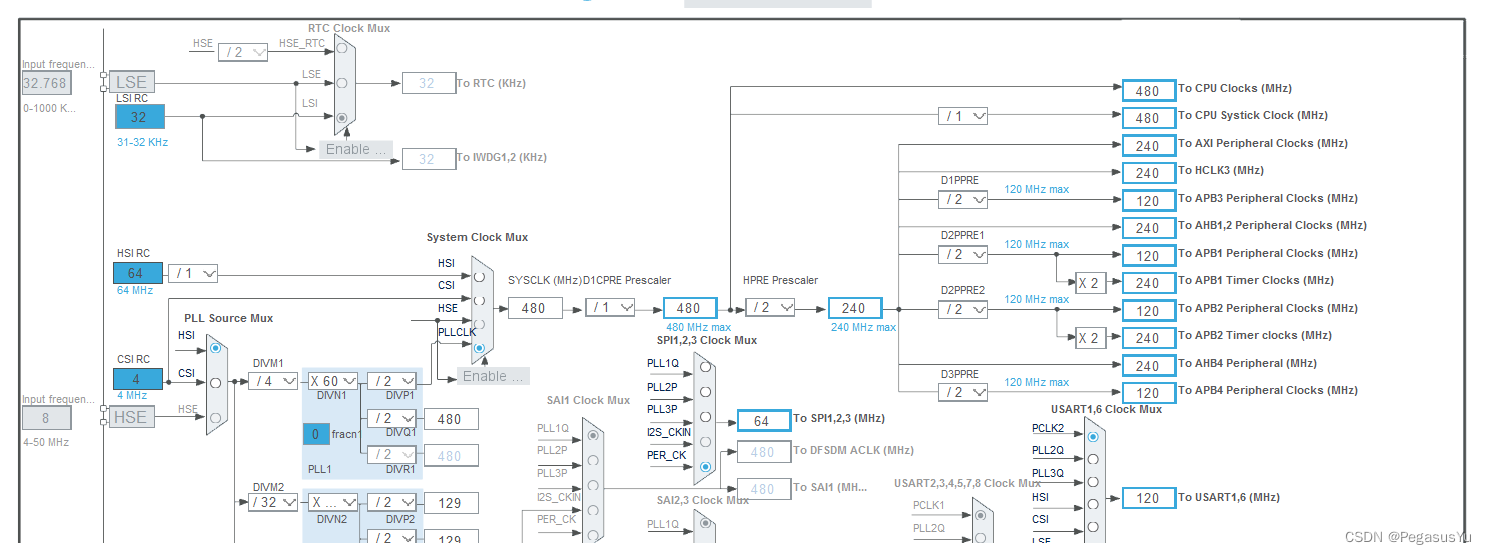

设置UART1作为通讯串口:
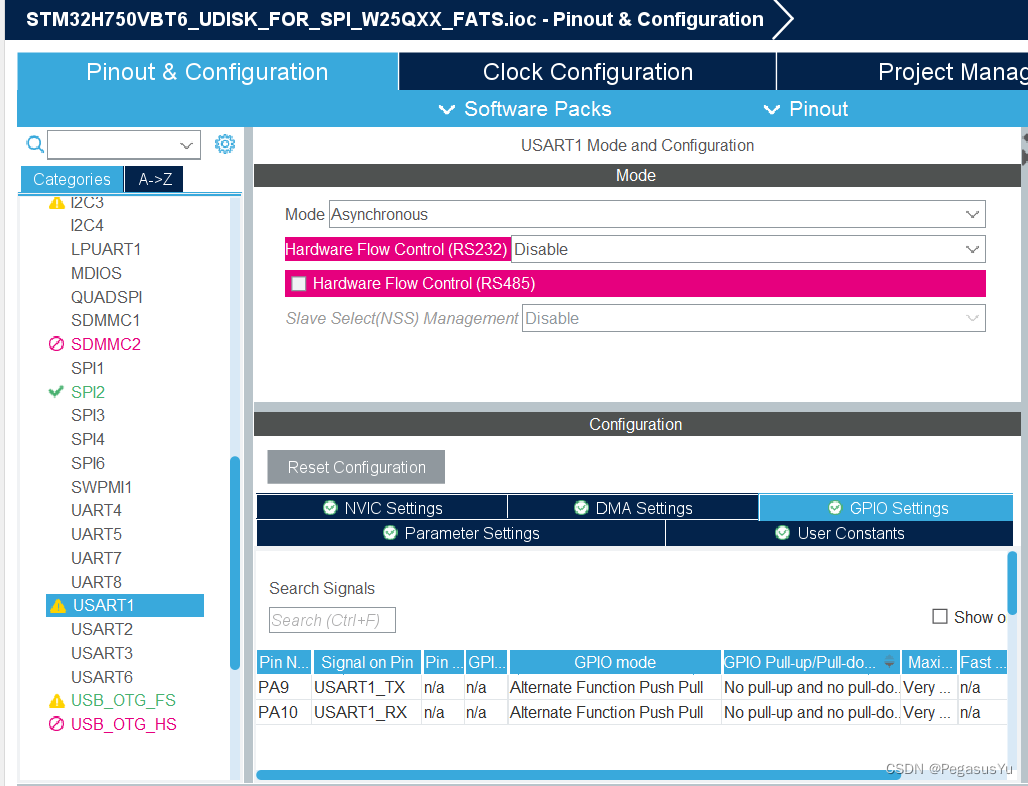
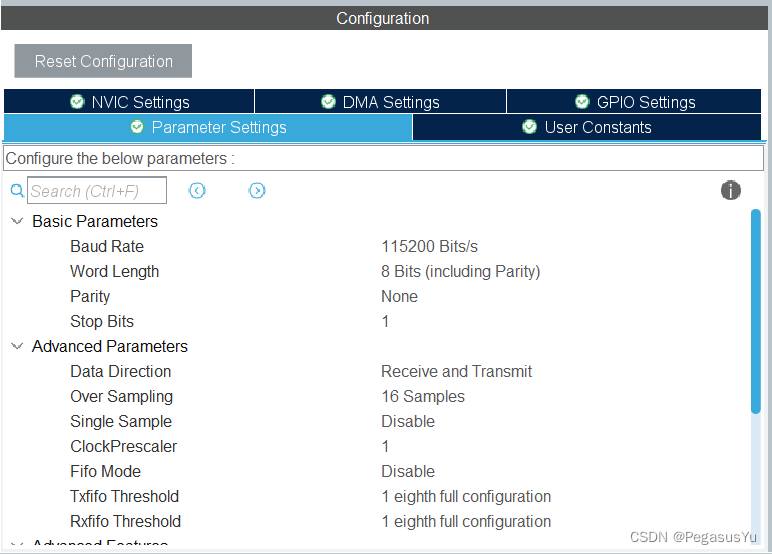


FLASH连接到了SPI2接口,对SPI2进行配置:
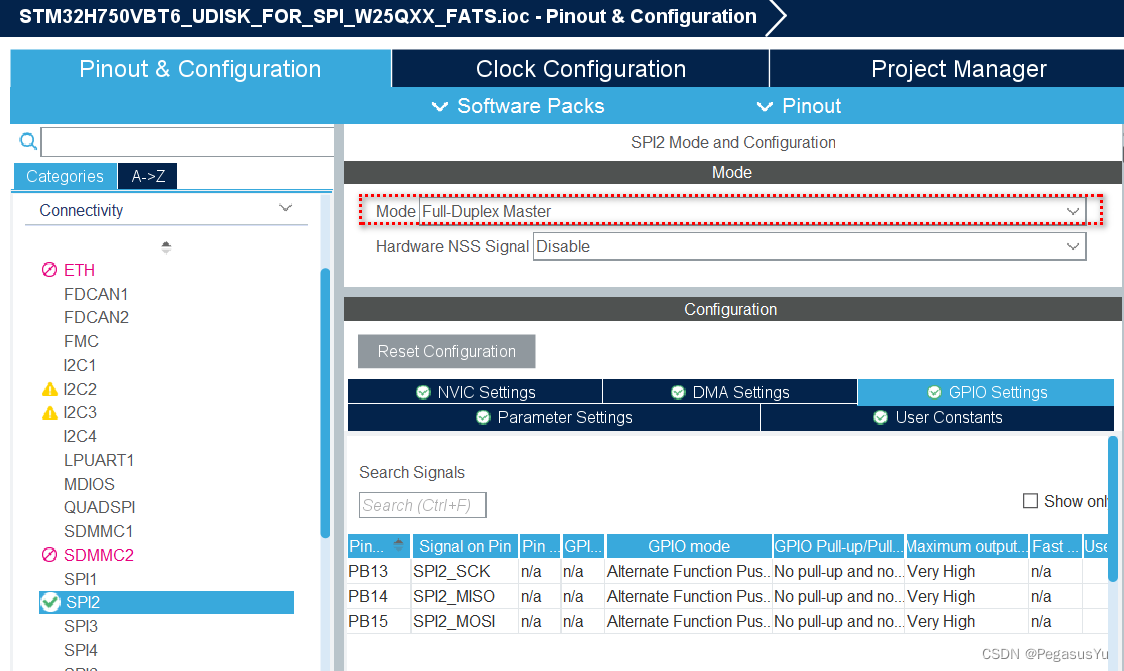

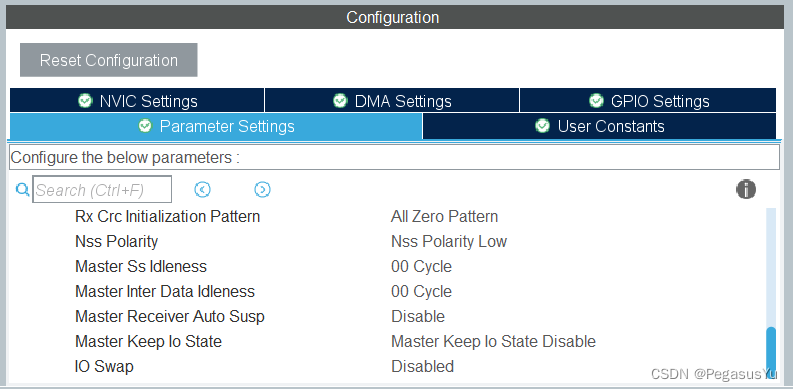
不用中断和DMA模式,SPI2的片选才用软件代码控制,配置一个GPIO作为片选输出:
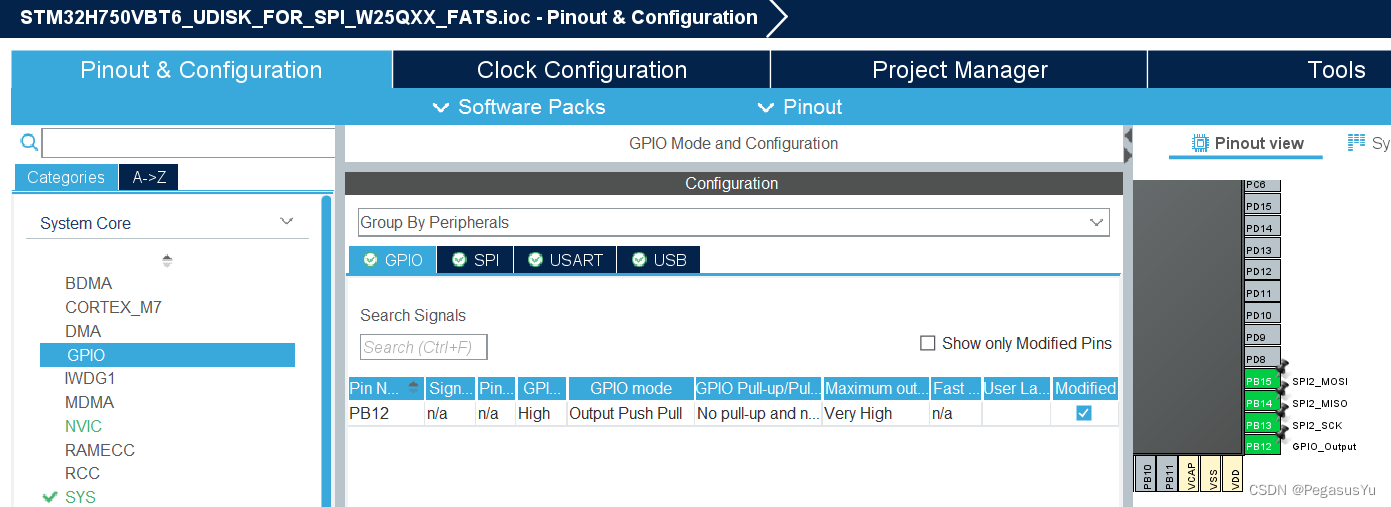
配置USB接口
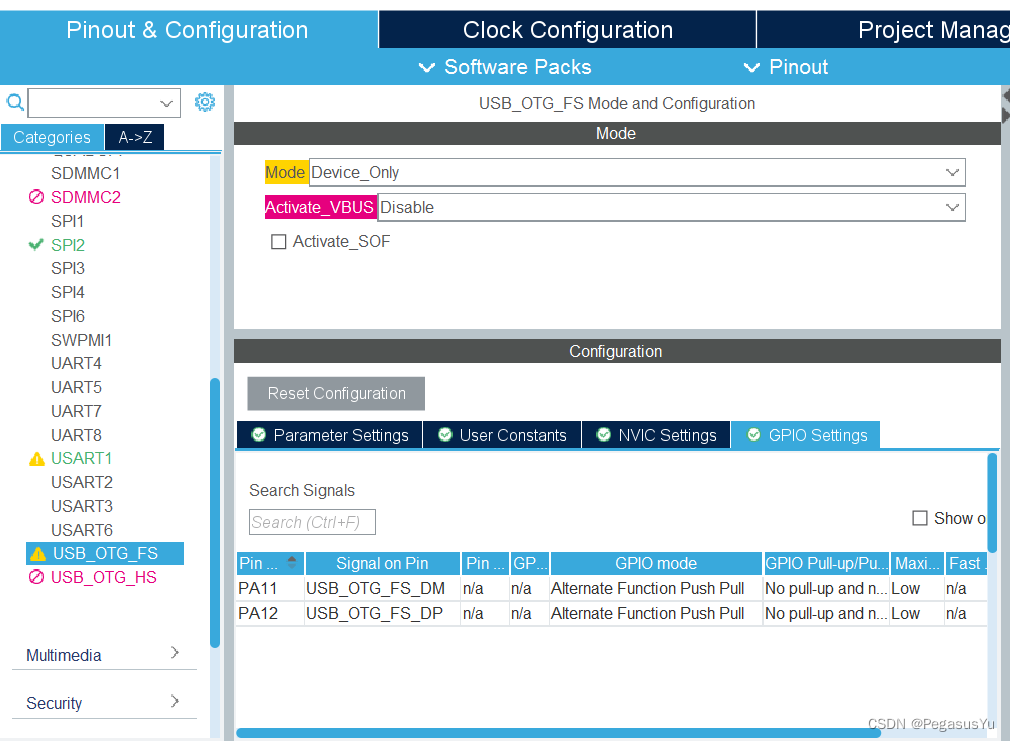
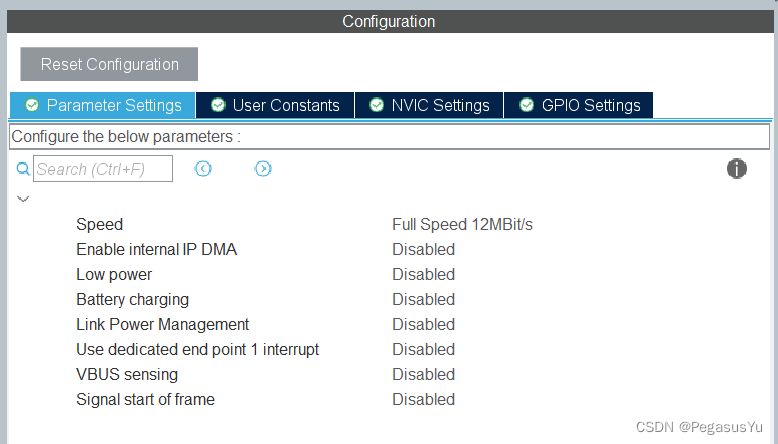

将USB接口例化为U盘模式:
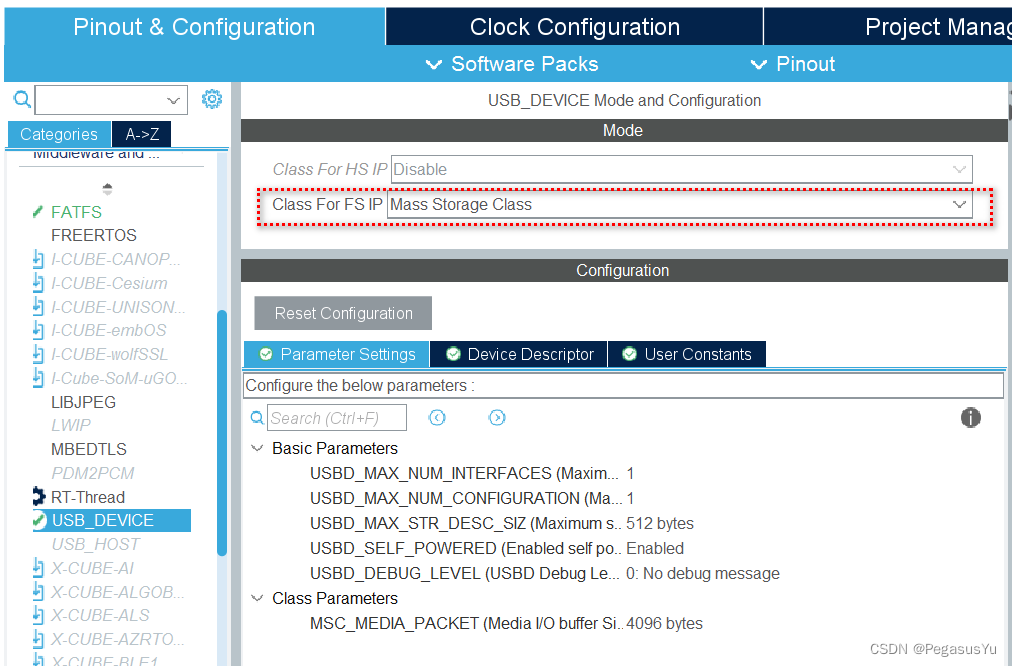
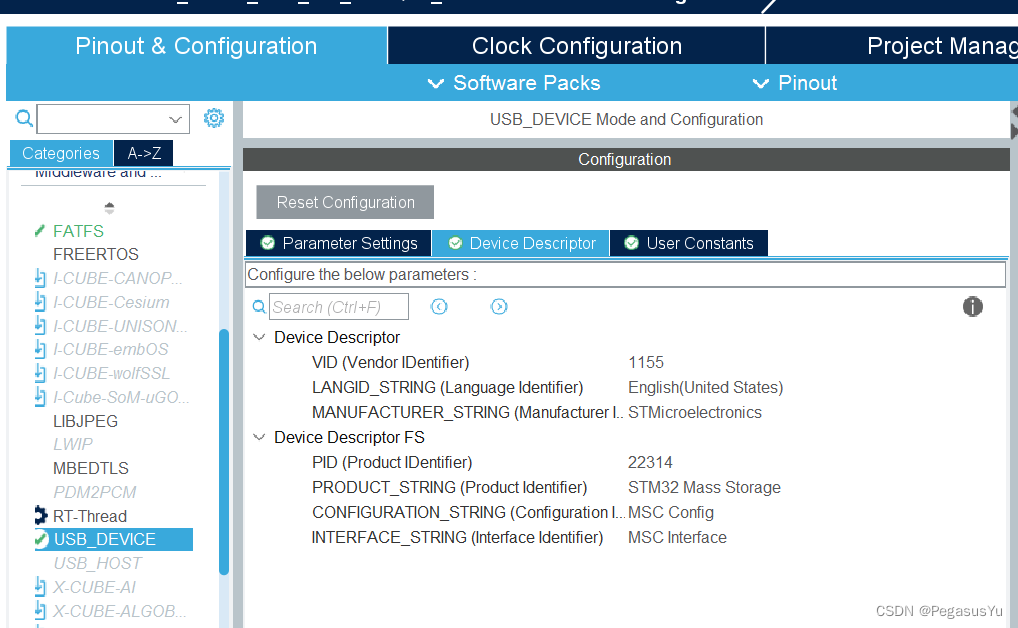
对FATS文件系统进行配置
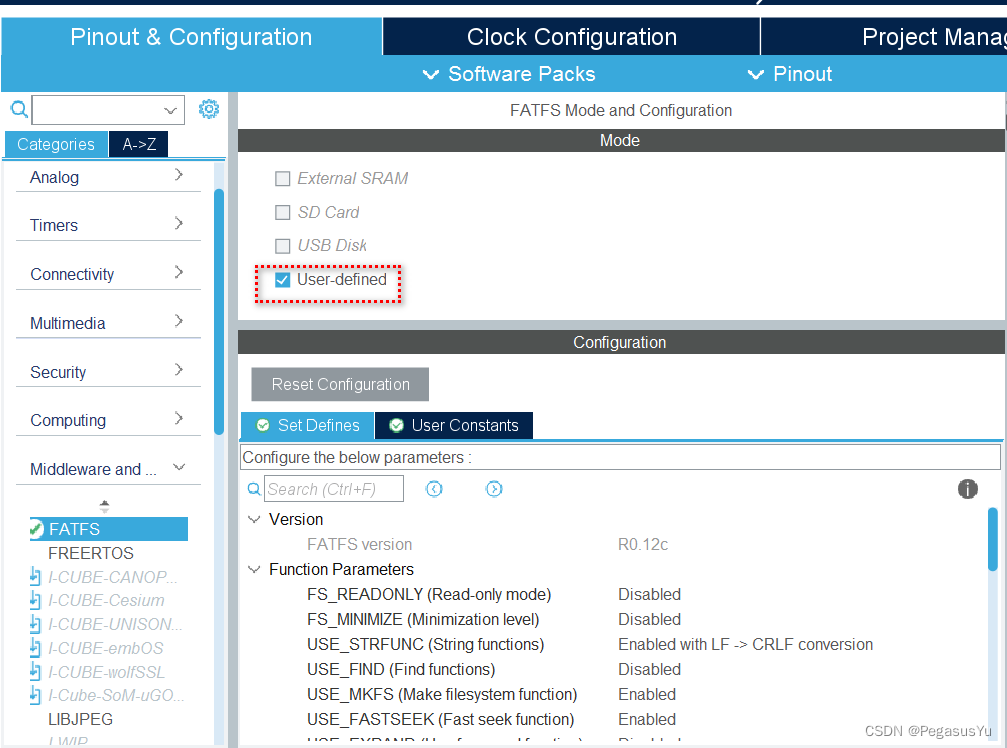
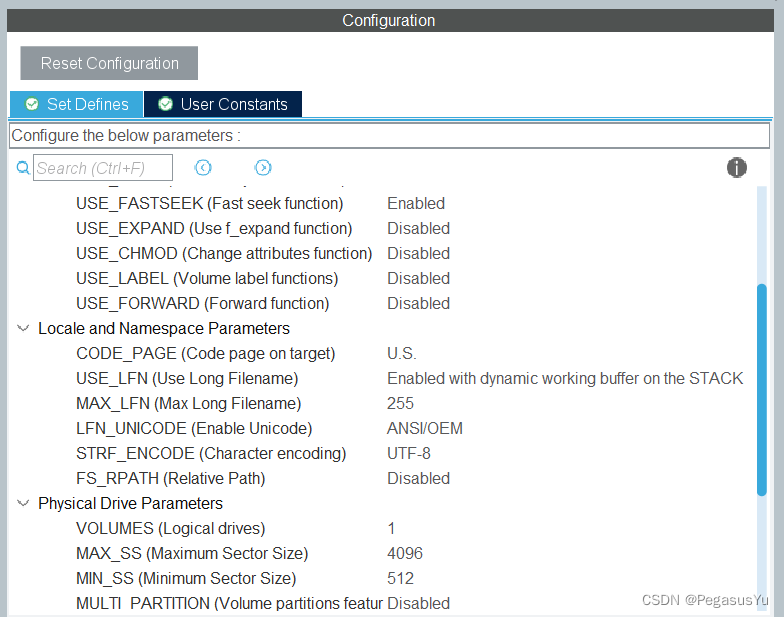
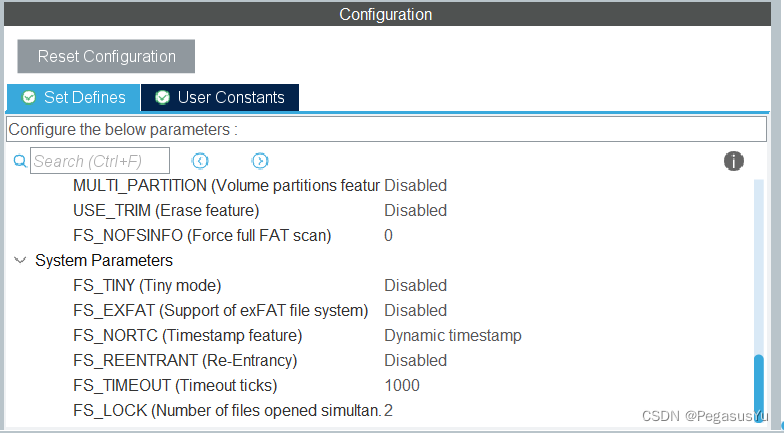
STM32H7资源多,可以将堆栈开大些:
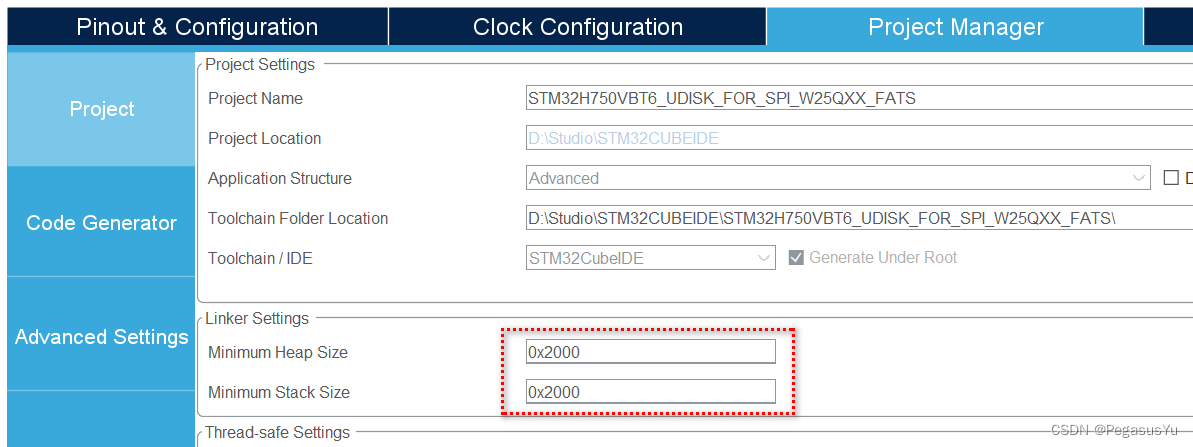
保存并生成初始工程代码:
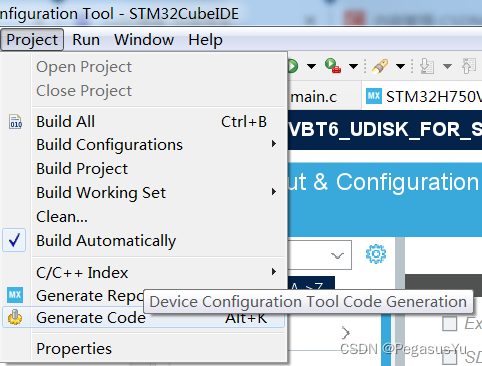
STM32工程代码
UART串口printf打印输出实现参考:STM32 UART串口printf函数应用及浮点打印代码空间节省 (HAL)
建立W25Q访问的库头文件W25QXX.h:
#ifndef INC_W25QXX_H_
#define INC_W25QXX_H_#include "main.h"uint8_t SPI2_ReadWriteByte(uint8_t TxData);//W25QXX serial chip list:
#define W25Q80_ID 0XEF13
#define W25Q16_ID 0XEF14
#define W25Q32_ID 0XEF15
#define W25Q64_ID 0XEF16
#define W25Q128_ID 0XEF17
#define W25Q256_ID 0XEF18
#define W25Q512_ID 0XEF19
#define W25Q1024_ID 0XEF20extern uint16_t W25QXX_TYPE; //To indicate W25QXX type used in this procedure//W25QXX chip select control function
#define W25QXX_CS(n) ( n ? HAL_GPIO_WritePin(GPIOB, GPIO_PIN_12, GPIO_PIN_SET) : HAL_GPIO_WritePin(GPIOB, GPIO_PIN_12, GPIO_PIN_RESET) )//command table for W25QXX access
#define W25X_WriteEnable 0x06
#define W25X_WriteDisable 0x04
#define W25X_ReadStatusReg1 0x05
#define W25X_ReadStatusReg2 0x35
#define W25X_ReadStatusReg3 0x15
#define W25X_WriteStatusReg1 0x01
#define W25X_WriteStatusReg2 0x31
#define W25X_WriteStatusReg3 0x11
#define W25X_ReadData 0x03
#define W25X_FastReadData 0x0B
#define W25X_FastReadDual 0x3B
#define W25X_PageProgram 0x02
#define W25X_BlockErase 0xD8
#define W25X_SectorErase 0x20
#define W25X_ChipErase 0xC7
#define W25X_PowerDown 0xB9
#define W25X_ReleasePowerDown 0xAB
#define W25X_DeviceID 0xAB
#define W25X_ManufactDeviceID 0x90
#define W25X_JedecDeviceID 0x9F
#define W25X_Enable4ByteAddr 0xB7
#define W25X_Exit4ByteAddr 0xE9uint8_t W25QXX_Init(void);
uint16_t W25QXX_ReadID(void); //Read W25QXX ID
uint8_t W25QXX_ReadSR(uint8_t reg_num); //Read from status register
void W25QXX_4ByteAddr_Enable(void); //Enable 4-byte address mode
void W25QXX_Write_SR(uint8_t reg_num,uint8_t d); //Write to status register
void W25QXX_Write_Enable(void); //Write enable
void W25QXX_Write_Disable(void); //Write disable
void W25QXX_Write_NoCheck(uint8_t* pBuffer,uint32_t WriteAddr,uint16_t NumByteToWrite); //Write operation w/o check
void W25QXX_Read(uint8_t* pBuffer,uint32_t ReadAddr,uint16_t NumByteToRead); //Read operation
void W25QXX_Write(uint8_t* pBuffer,uint32_t WriteAddr,uint16_t NumByteToWrite); //Write operation
void W25QXX_Erase_Chip(void); //Erase whole chip
void W25QXX_Erase_Sector(uint32_t Sector_Num); //Erase sector in specific sector number
void W25QXX_Wait_Busy(void); //Wait idle status before next operation
void W25QXX_PowerDown(void); //Enter power-down mode
void W25QXX_WAKEUP(void); //Wake-up#endif /* INC_W25QXX_H_ */建立W25Q访问的库源文件W25QXX.c:
#include "W25QXX.h"extern SPI_HandleTypeDef hspi2;
extern void PY_Delay_us_t(uint32_t Delay);
//Write and read one byte in SPI2
uint8_t SPI2_ReadWriteByte(uint8_t TxData)
{uint8_t Rxdata;HAL_SPI_TransmitReceive(&hspi2,&TxData,&Rxdata,1, 1000);return Rxdata;
}uint16_t W25QXX_TYPE=W25Q64_ID;//W25QXX initialization
uint8_t W25QXX_Init(void)
{uint8_t temp;W25QXX_CS(1);W25QXX_TYPE=W25QXX_ReadID();if((W25QXX_TYPE==W25Q256_ID)||(W25QXX_TYPE==W25Q512_ID)||(W25QXX_TYPE==W25Q1024_ID)){temp=W25QXX_ReadSR(3); //read status register 3if((temp&0X01)==0) //judge address mode and configure to 4-byte address mode{W25QXX_CS(0);SPI2_ReadWriteByte(W25X_Enable4ByteAddr);W25QXX_CS(1);}}if((W25QXX_TYPE==0x0000)||(W25QXX_TYPE==0xFFFF)) return 0;else return 1;
}//Read status registers of W25QXX
//reg_num: register number from 1 to 3
//return: value of selected register//SR1 (default 0x00):
//BIT7 6 5 4 3 2 1 0
//SPR RV TB BP2 BP1 BP0 WEL BUSY
//SPR: default 0, status register protection bit used with WP
//TB,BP2,BP1,BP0: FLASH region write protection configuration
//WEL: write enable lock
//BUSY: busy flag (1: busy; 0: idle)//SR2:
//BIT7 6 5 4 3 2 1 0
//SUS CMP LB3 LB2 LB1 (R) QE SRP1//SR3:
//BIT7 6 5 4 3 2 1 0
//HOLD/RST DRV1 DRV0 (R) (R) WPS ADP ADS
uint8_t W25QXX_ReadSR(uint8_t reg_num)
{uint8_t byte=0,command=0;switch(reg_num){case 1:command=W25X_ReadStatusReg1; //To read status register 1break;case 2:command=W25X_ReadStatusReg2; //To read status register 2break;case 3:command=W25X_ReadStatusReg3; //To read status register 3break;default:command=W25X_ReadStatusReg1;break;}W25QXX_CS(0);SPI2_ReadWriteByte(command); //send commandbyte=SPI2_ReadWriteByte(0Xff); //read dataW25QXX_CS(1);return byte;
}//Write status registers of W25QXX
//reg_num: register number from 1 to 3
//d: data for updating status register
void W25QXX_Write_SR(uint8_t reg_num,uint8_t d)
{uint8_t command=0;switch(reg_num){case 1:command=W25X_WriteStatusReg1; //To write status register 1break;case 2:command=W25X_WriteStatusReg2; //To write status register 2break;case 3:command=W25X_WriteStatusReg3; //To write status register 3break;default:command=W25X_WriteStatusReg1;break;}W25QXX_CS(0);SPI2_ReadWriteByte(command); //send commandSPI2_ReadWriteByte(d); //write dataW25QXX_CS(1);
}
//W25QXX write enable
void W25QXX_Write_Enable(void)
{W25QXX_CS(0);SPI2_ReadWriteByte(W25X_WriteEnable);W25QXX_CS(1);
}
//W25QXX write disable
void W25QXX_Write_Disable(void)
{W25QXX_CS(0);SPI2_ReadWriteByte(W25X_WriteDisable);W25QXX_CS(1);
}//Read chip ID
//return:
//0XEF13 for W25Q80
//0XEF14 for W25Q16
//0XEF15 for W25Q32
//0XEF16 for W25Q64
//0XEF17 for W25Q128
//0XEF18 for W25Q256
uint16_t W25QXX_ReadID(void)
{uint16_t Temp = 0;W25QXX_CS(0);SPI2_ReadWriteByte(0x90); //send commandSPI2_ReadWriteByte(0x00);SPI2_ReadWriteByte(0x00);SPI2_ReadWriteByte(0x00);Temp|=SPI2_ReadWriteByte(0xFF)<<8; //read high byte dataTemp|=SPI2_ReadWriteByte(0xFF); //read low byte dataW25QXX_CS(1);return Temp;
}
//Read W25QXX from specific address for specific byte length
//pBuffer: data buffer
//ReadAddr: specific address
//NumByteToRead: specific byte length (max 65535)
void W25QXX_Read(uint8_t* pBuffer,uint32_t ReadAddr,uint16_t NumByteToRead)
{uint16_t i;W25QXX_CS(0);SPI2_ReadWriteByte(W25X_ReadData); //send read commandif((W25QXX_TYPE==W25Q256_ID)||(W25QXX_TYPE==W25Q512_ID)||(W25QXX_TYPE==W25Q1024_ID)) //send highest 8-bit address{SPI2_ReadWriteByte((uint8_t)((ReadAddr)>>24));}SPI2_ReadWriteByte((uint8_t)((ReadAddr)>>16)); //send 24-bit addressSPI2_ReadWriteByte((uint8_t)((ReadAddr)>>8));SPI2_ReadWriteByte((uint8_t)ReadAddr);for(i=0;i<NumByteToRead;i++){pBuffer[i]=SPI2_ReadWriteByte(0XFF); //read data}W25QXX_CS(1);
}//Write W25QXX not more than 1 page (256 bytes)
//pBuffer: data buffer
//WriteAddr: specific address
//NumByteToWrite: specific byte length (max 256)
void W25QXX_Write_Page(uint8_t* pBuffer,uint32_t WriteAddr,uint16_t NumByteToWrite)
{uint16_t i;W25QXX_Write_Enable(); //write enableW25QXX_CS(0);SPI2_ReadWriteByte(W25X_PageProgram); //send write commandif((W25QXX_TYPE==W25Q256_ID)||(W25QXX_TYPE==W25Q512_ID)||(W25QXX_TYPE==W25Q1024_ID)) //send highest 8-bit address{SPI2_ReadWriteByte((uint8_t)((WriteAddr)>>24));}SPI2_ReadWriteByte((uint8_t)((WriteAddr)>>16)); //send 24-bit addressSPI2_ReadWriteByte((uint8_t)((WriteAddr)>>8));SPI2_ReadWriteByte((uint8_t)WriteAddr);for(i=0;i<NumByteToWrite;i++)SPI2_ReadWriteByte(pBuffer[i]); //write dataW25QXX_CS(1);W25QXX_Wait_Busy();
}//Write W25QXX w/o erase check and w/o byte number restriction
//pBuffer: data buffer
//WriteAddr: specific address
//NumByteToWrite: specific byte length (max 65535)
void W25QXX_Write_NoCheck(uint8_t* pBuffer,uint32_t WriteAddr,uint16_t NumByteToWrite)
{uint16_t remained_byte_num_in_page;remained_byte_num_in_page=256-WriteAddr%256; //remained byte number in pageif( NumByteToWrite <= remained_byte_num_in_page ) remained_byte_num_in_page = NumByteToWrite; //data can be written in single pagewhile(1){W25QXX_Write_Page(pBuffer,WriteAddr,remained_byte_num_in_page);if(NumByteToWrite==remained_byte_num_in_page)break; //end write operationelse //NumByteToWrite>remained_byte_num_in_page{pBuffer+=remained_byte_num_in_page;WriteAddr+=remained_byte_num_in_page;NumByteToWrite-=remained_byte_num_in_page;if(NumByteToWrite>256)remained_byte_num_in_page=256; //for whole page writeelse remained_byte_num_in_page=NumByteToWrite; //for non-whole page write}};
}//Write W25QXX w/ erase after check and w/o byte number restriction
//pBuffer: data buffer
//WriteAddr: specific address
//NumByteToWrite: specific byte length (max 65535)
uint8_t W25QXX_BUFFER[4096];
void W25QXX_Write(uint8_t* pBuffer,uint32_t WriteAddr,uint16_t NumByteToWrite)
{uint32_t secpos;uint16_t secoff;uint16_t secremain;uint16_t i;uint8_t * W25QXX_BUF;W25QXX_BUF=W25QXX_BUFFER;secpos=WriteAddr/4096; //sector number (16 pages for 1 sector) for destination addresssecoff=WriteAddr%4096; //offset address in sector for destination addresssecremain=4096-secoff; //remained space for sectorif(NumByteToWrite<=secremain)secremain=NumByteToWrite; //data can be written in single sectorwhile(1){W25QXX_Read(W25QXX_BUF,secpos*4096,4096); //read sector data for ease necessity judgmentfor(i=0;i<secremain;i++) //check sector data status{if(W25QXX_BUF[secoff+i]!=0XFF) break; //ease necessary}if(i<secremain) //for ease{W25QXX_Erase_Sector(secpos); //ease sectorfor(i=0;i<secremain;i++) //data copy{W25QXX_BUF[i+secoff]=pBuffer[i];}W25QXX_Write_NoCheck(W25QXX_BUF,secpos*4096,4096); //write sector}else W25QXX_Write_NoCheck(pBuffer,WriteAddr,secremain); //write data for sector unnecessary to eraseif(NumByteToWrite==secremain)break; //for operation endelse //for operation continuing{secpos++; //sector number + 1secoff=0; //offset address from 0pBuffer+=secremain; //pointer adjustmentWriteAddr+=secremain; //write address adjustmentNumByteToWrite-=secremain; //write number adjustmentif(NumByteToWrite>4096) secremain=4096; //not last sectorelse secremain=NumByteToWrite; //last sector}};
}//Erase whole chip, long waiting...
void W25QXX_Erase_Chip(void)
{W25QXX_Write_Enable(); //write enableW25QXX_Wait_Busy();W25QXX_CS(0);SPI2_ReadWriteByte(W25X_ChipErase); //send erase commandW25QXX_CS(1);W25QXX_Wait_Busy(); //wait for erase complete
}//Erase one sector
//Sector_Num: sector number
void W25QXX_Erase_Sector(uint32_t Sector_Num)
{Sector_Num*=4096;W25QXX_Write_Enable(); //write enableW25QXX_Wait_Busy();W25QXX_CS(0);SPI2_ReadWriteByte(W25X_SectorErase); //send erase commandif((W25QXX_TYPE==W25Q256_ID)||(W25QXX_TYPE==W25Q512_ID)||(W25QXX_TYPE==W25Q1024_ID)) //send highest 8-bit address{SPI2_ReadWriteByte((uint8_t)((Sector_Num)>>24));}SPI2_ReadWriteByte((uint8_t)((Sector_Num)>>16)); //send 24-bit addressSPI2_ReadWriteByte((uint8_t)((Sector_Num)>>8));SPI2_ReadWriteByte((uint8_t)Sector_Num);W25QXX_CS(1);W25QXX_Wait_Busy(); //wait for erase complete
}//Wait idle status before next operation
void W25QXX_Wait_Busy(void)
{while((W25QXX_ReadSR(1)&0x01)==0x01); //wait for busy flag cleared
}//Enter power-down mode
#define tDP_us 3
void W25QXX_PowerDown(void)
{W25QXX_CS(0);SPI2_ReadWriteByte(W25X_PowerDown); //send power-down commandW25QXX_CS(1);PY_Delay_us_t(tDP_us); //tDP
}
//Wake-up
#define tRES1_us 3
void W25QXX_WAKEUP(void)
{W25QXX_CS(0);SPI2_ReadWriteByte(W25X_ReleasePowerDown);//send release power-down commandW25QXX_CS(1);PY_Delay_us_t(tRES1_us); //tRES1
}
对ffconf.h添加包含信息:

#include "main.h"
#include "stm32h7xx_hal.h"
修改user_diskio.c,对文件操作函数与底层FLASH读写提供连接:
/* USER CODE BEGIN Header */
/********************************************************************************* @file user_diskio.c* @brief This file includes a diskio driver skeleton to be completed by the user.******************************************************************************* @attention** Copyright (c) 2023 STMicroelectronics.* All rights reserved.** This software is licensed under terms that can be found in the LICENSE file* in the root directory of this software component.* If no LICENSE file comes with this software, it is provided AS-IS.********************************************************************************//* USER CODE END Header */#ifdef USE_OBSOLETE_USER_CODE_SECTION_0
/** Warning: the user section 0 is no more in use (starting from CubeMx version 4.16.0)* To be suppressed in the future.* Kept to ensure backward compatibility with previous CubeMx versions when* migrating projects.* User code previously added there should be copied in the new user sections before* the section contents can be deleted.*/
/* USER CODE BEGIN 0 */
/* USER CODE END 0 */
#endif/* USER CODE BEGIN DECL */
/**************************SELF DEFINITION PART************/
#include "diskio.h" /* Declarations of disk functions */
#include "W25QXX.h"
/**********************************************************/
/* Includes ------------------------------------------------------------------*/
#include <string.h>
#include "ff_gen_drv.h"/* Private typedef -----------------------------------------------------------*/
/* Private define ------------------------------------------------------------*//* Private variables ---------------------------------------------------------*/
/* Disk status */
static volatile DSTATUS Stat = STA_NOINIT;/* USER CODE END DECL *//* Private function prototypes -----------------------------------------------*/
DSTATUS USER_initialize (BYTE pdrv);
DSTATUS USER_status (BYTE pdrv);
DRESULT USER_read (BYTE pdrv, BYTE *buff, DWORD sector, UINT count);
#if _USE_WRITE == 1DRESULT USER_write (BYTE pdrv, const BYTE *buff, DWORD sector, UINT count);
#endif /* _USE_WRITE == 1 */
#if _USE_IOCTL == 1DRESULT USER_ioctl (BYTE pdrv, BYTE cmd, void *buff);
#endif /* _USE_IOCTL == 1 */Diskio_drvTypeDef USER_Driver =
{USER_initialize,USER_status,USER_read,
#if _USE_WRITEUSER_write,
#endif /* _USE_WRITE == 1 */
#if _USE_IOCTL == 1USER_ioctl,
#endif /* _USE_IOCTL == 1 */
};/* Private functions ---------------------------------------------------------*//*** @brief Initializes a Drive* @param pdrv: Physical drive number (0..)* @retval DSTATUS: Operation status*/
DSTATUS USER_initialize (BYTE pdrv /* Physical drive nmuber to identify the drive */
)
{/* USER CODE BEGIN INIT *//**************************SELF DEFINITION PART************/uint8_t res;res = W25QXX_Init();if(res) return RES_OK;else return STA_NOINIT;/**********************************************************//*Stat = STA_NOINIT;return Stat;*//* USER CODE END INIT */
}/*** @brief Gets Disk Status* @param pdrv: Physical drive number (0..)* @retval DSTATUS: Operation status*/
DSTATUS USER_status (BYTE pdrv /* Physical drive number to identify the drive */
)
{/* USER CODE BEGIN STATUS *//**************************SELF DEFINITION PART************/switch (pdrv){case 0 :return RES_OK;case 1 :return RES_OK;case 2 :return RES_OK;default:return STA_NOINIT;}/**********************************************************//*Stat = STA_NOINIT;return Stat;*//* USER CODE END STATUS */
}/*** @brief Reads Sector(s)* @param pdrv: Physical drive number (0..)* @param *buff: Data buffer to store read data* @param sector: Sector address (LBA)* @param count: Number of sectors to read (1..128)* @retval DRESULT: Operation result*/
DRESULT USER_read (BYTE pdrv, /* Physical drive nmuber to identify the drive */BYTE *buff, /* Data buffer to store read data */DWORD sector, /* Sector address in LBA */UINT count /* Number of sectors to read */
)
{/* USER CODE BEGIN READ *//**************************SELF DEFINITION PART************/uint16_t len;if( !count ){return RES_PARERR; /* count不能等于0,否则返回参数错误 */}switch (pdrv){case 0:sector <<= 9; //Convert sector number to byte addresslen = count*512;W25QXX_Read(buff, sector, len);return RES_OK;default:return RES_ERROR;}/**********************************************************//*return RES_OK;*//* USER CODE END READ */
}/*** @brief Writes Sector(s)* @param pdrv: Physical drive number (0..)* @param *buff: Data to be written* @param sector: Sector address (LBA)* @param count: Number of sectors to write (1..128)* @retval DRESULT: Operation result*/
#if _USE_WRITE == 1
DRESULT USER_write (BYTE pdrv, /* Physical drive nmuber to identify the drive */const BYTE *buff, /* Data to be written */DWORD sector, /* Sector address in LBA */UINT count /* Number of sectors to write */
)
{/* USER CODE BEGIN WRITE *//* USER CODE HERE *//**************************SELF DEFINITION PART************/uint16_t len;if( !count ){return RES_PARERR; /* count不能等于0,否则返回参数错误 */}switch (pdrv){case 0:sector <<= 9; //Convert sector number to byte addresslen = count*512;W25QXX_Write((uint8_t *)buff, sector, len);return RES_OK;default:return RES_ERROR;}/*********************************************************//*return RES_OK;*//* USER CODE END WRITE */
}
#endif /* _USE_WRITE == 1 *//*** @brief I/O control operation* @param pdrv: Physical drive number (0..)* @param cmd: Control code* @param *buff: Buffer to send/receive control data* @retval DRESULT: Operation result*/
#if _USE_IOCTL == 1
DRESULT USER_ioctl (BYTE pdrv, /* Physical drive nmuber (0..) */BYTE cmd, /* Control code */void *buff /* Buffer to send/receive control data */
)
{/* USER CODE BEGIN IOCTL *//**************************SELF DEFINITION PART************/#define user_sector_byte_size 512DRESULT res;switch(cmd){case CTRL_SYNC:W25QXX_Wait_Busy();res=RES_OK;break;case GET_SECTOR_SIZE:*(WORD*)buff = user_sector_byte_size;res = RES_OK;break;case GET_BLOCK_SIZE:*(WORD*)buff = 4096/user_sector_byte_size;res = RES_OK;break;case GET_SECTOR_COUNT:W25QXX_TYPE=W25QXX_ReadID();if(W25QXX_TYPE==W25Q80_ID) *(DWORD*)buff = (8*1024*1024/512);else if(W25QXX_TYPE==W25Q16_ID) *(DWORD*)buff = (16*1024*1024/512);else if(W25QXX_TYPE==W25Q32_ID) *(DWORD*)buff = (32*1024*1024/512);else if(W25QXX_TYPE==W25Q64_ID) *(DWORD*)buff = (64*1024*1024/512);else if(W25QXX_TYPE==W25Q128_ID) *(DWORD*)buff = (128*1024*1024/512);else if(W25QXX_TYPE==W25Q256_ID) *(DWORD*)buff = (256*1024*1024/512);else if(W25QXX_TYPE==W25Q512_ID) *(DWORD*)buff = (512*1024*1024/512);else if(W25QXX_TYPE==W25Q1024_ID) *(DWORD*)buff = (1024*1024*1024/512);else *(DWORD*)buff = (8*1024*1024/512);res = RES_OK;break;default:res = RES_PARERR;break;}return res;/**********************************************************//*DRESULT res = RES_ERROR;return res;*//* USER CODE END IOCTL */
}
#endif /* _USE_IOCTL == 1 */上面配置的FATS协议是用户可操作的显式协议,譬如本例程通过串口发送指令后控制对FLASH的FATS操作。STM32的U盘接口相当于包含对PC端的握手协议和对内部的隐式FATS协议,还需要配置底层对针对的存储单元读写操作函数。
配置U盘接口包含如下部分:
引入头文件申明

设置U盘识别的大小参数:
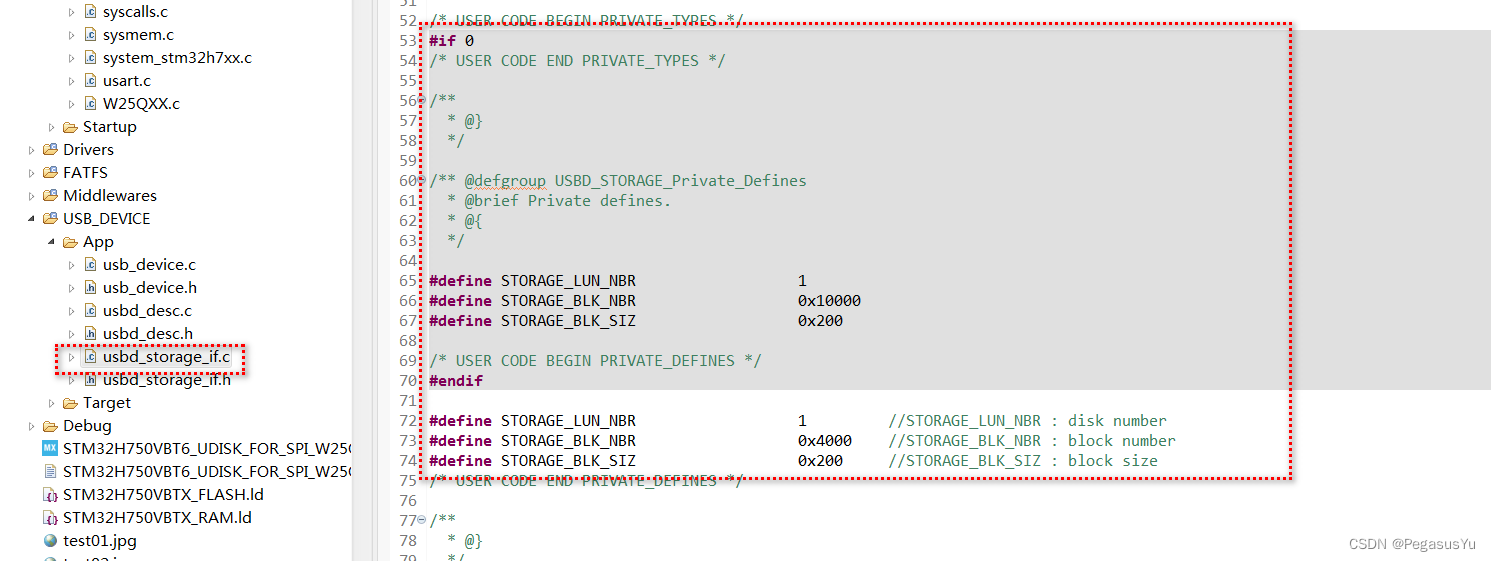
这里0x4000对应16K,0x200对应512(字节), 16K*512=8M, 所以U盘会识别为8MB的U盘。
然后是U盘初始化的设置

U盘识别时获取U盘容量的函数

然后再配置读操作和写操作函数
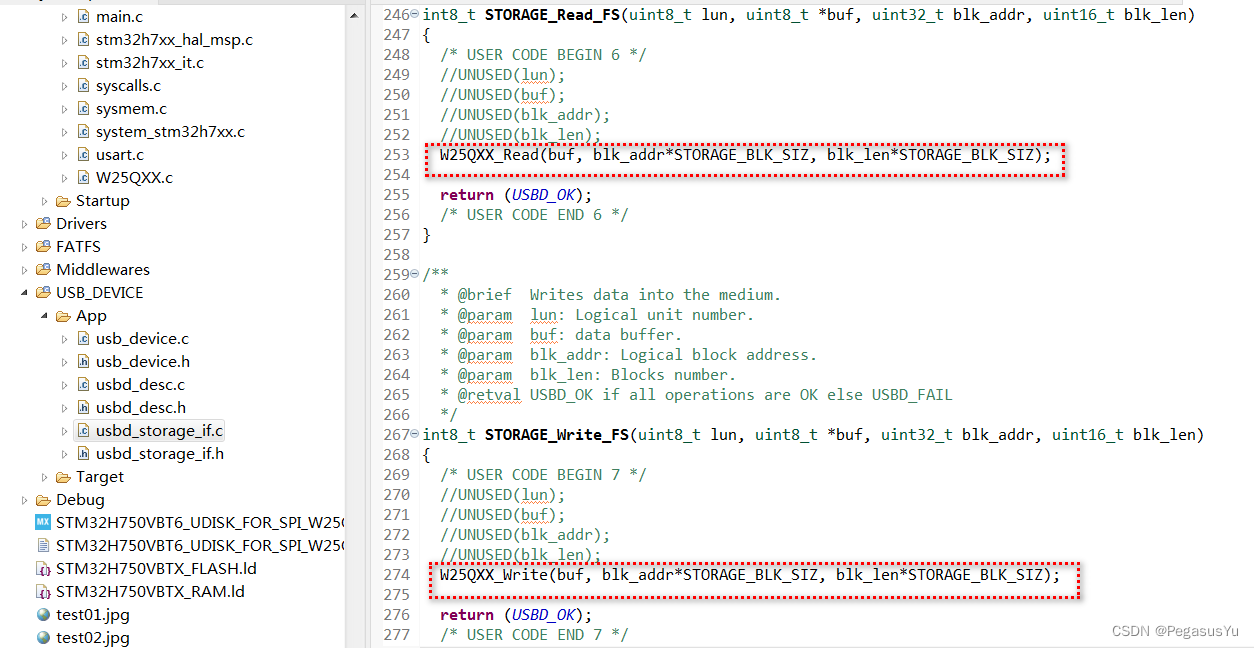
完整的代码如下:
/* USER CODE BEGIN Header */
/********************************************************************************* @file : usbd_storage_if.c* @version : v1.0_Cube* @brief : Memory management layer.******************************************************************************* @attention** Copyright (c) 2023 STMicroelectronics.* All rights reserved.** This software is licensed under terms that can be found in the LICENSE file* in the root directory of this software component.* If no LICENSE file comes with this software, it is provided AS-IS.********************************************************************************/
/* USER CODE END Header *//* Includes ------------------------------------------------------------------*/
#include "usbd_storage_if.h"/* USER CODE BEGIN INCLUDE */
#include "W25QXX.h"
/* USER CODE END INCLUDE *//* Private typedef -----------------------------------------------------------*/
/* Private define ------------------------------------------------------------*/
/* Private macro -------------------------------------------------------------*//* USER CODE BEGIN PV */
/* Private variables ---------------------------------------------------------*//* USER CODE END PV *//** @addtogroup STM32_USB_OTG_DEVICE_LIBRARY* @brief Usb device.* @{*//** @defgroup USBD_STORAGE* @brief Usb mass storage device module* @{*//** @defgroup USBD_STORAGE_Private_TypesDefinitions* @brief Private types.* @{*//* USER CODE BEGIN PRIVATE_TYPES */
#if 0
/* USER CODE END PRIVATE_TYPES *//*** @}*//** @defgroup USBD_STORAGE_Private_Defines* @brief Private defines.* @{*/#define STORAGE_LUN_NBR 1
#define STORAGE_BLK_NBR 0x10000
#define STORAGE_BLK_SIZ 0x200/* USER CODE BEGIN PRIVATE_DEFINES */
#endif#define STORAGE_LUN_NBR 1 //STORAGE_LUN_NBR : disk number
#define STORAGE_BLK_NBR 0x4000 //STORAGE_BLK_NBR : block number
#define STORAGE_BLK_SIZ 0x200 //STORAGE_BLK_SIZ : block size
/* USER CODE END PRIVATE_DEFINES *//*** @}*//** @defgroup USBD_STORAGE_Private_Macros* @brief Private macros.* @{*//* USER CODE BEGIN PRIVATE_MACRO *//* USER CODE END PRIVATE_MACRO *//*** @}*//** @defgroup USBD_STORAGE_Private_Variables* @brief Private variables.* @{*//* USER CODE BEGIN INQUIRY_DATA_FS */
/** USB Mass storage Standard Inquiry Data. */
const int8_t STORAGE_Inquirydata_FS[] = {/* 36 *//* LUN 0 */0x00,0x80,0x02,0x02,(STANDARD_INQUIRY_DATA_LEN - 5),0x00,0x00,0x00,'S', 'T', 'M', ' ', ' ', ' ', ' ', ' ', /* Manufacturer : 8 bytes */'P', 'r', 'o', 'd', 'u', 'c', 't', ' ', /* Product : 16 Bytes */' ', ' ', ' ', ' ', ' ', ' ', ' ', ' ','0', '.', '0' ,'1' /* Version : 4 Bytes */
};
/* USER CODE END INQUIRY_DATA_FS *//* USER CODE BEGIN PRIVATE_VARIABLES *//* USER CODE END PRIVATE_VARIABLES *//*** @}*//** @defgroup USBD_STORAGE_Exported_Variables* @brief Public variables.* @{*/extern USBD_HandleTypeDef hUsbDeviceFS;/* USER CODE BEGIN EXPORTED_VARIABLES *//* USER CODE END EXPORTED_VARIABLES *//*** @}*//** @defgroup USBD_STORAGE_Private_FunctionPrototypes* @brief Private functions declaration.* @{*/static int8_t STORAGE_Init_FS(uint8_t lun);
static int8_t STORAGE_GetCapacity_FS(uint8_t lun, uint32_t *block_num, uint16_t *block_size);
static int8_t STORAGE_IsReady_FS(uint8_t lun);
static int8_t STORAGE_IsWriteProtected_FS(uint8_t lun);
static int8_t STORAGE_Read_FS(uint8_t lun, uint8_t *buf, uint32_t blk_addr, uint16_t blk_len);
static int8_t STORAGE_Write_FS(uint8_t lun, uint8_t *buf, uint32_t blk_addr, uint16_t blk_len);
static int8_t STORAGE_GetMaxLun_FS(void);/* USER CODE BEGIN PRIVATE_FUNCTIONS_DECLARATION *//* USER CODE END PRIVATE_FUNCTIONS_DECLARATION *//*** @}*/USBD_StorageTypeDef USBD_Storage_Interface_fops_FS =
{STORAGE_Init_FS,STORAGE_GetCapacity_FS,STORAGE_IsReady_FS,STORAGE_IsWriteProtected_FS,STORAGE_Read_FS,STORAGE_Write_FS,STORAGE_GetMaxLun_FS,(int8_t *)STORAGE_Inquirydata_FS
};/* Private functions ---------------------------------------------------------*/
/*** @brief Initializes the storage unit (medium) over USB FS IP* @param lun: Logical unit number.* @retval USBD_OK if all operations are OK else USBD_FAIL*/
int8_t STORAGE_Init_FS(uint8_t lun)
{/* USER CODE BEGIN 2 *///UNUSED(lun);W25QXX_Init();return (USBD_OK);/* USER CODE END 2 */
}/*** @brief Returns the medium capacity.* @param lun: Logical unit number.* @param block_num: Number of total block number.* @param block_size: Block size.* @retval USBD_OK if all operations are OK else USBD_FAIL*/
int8_t STORAGE_GetCapacity_FS(uint8_t lun, uint32_t *block_num, uint16_t *block_size)
{/* USER CODE BEGIN 3 *///UNUSED(lun);*block_num = STORAGE_BLK_NBR;*block_size = STORAGE_BLK_SIZ;return (USBD_OK);/* USER CODE END 3 */
}/*** @brief Checks whether the medium is ready.* @param lun: Logical unit number.* @retval USBD_OK if all operations are OK else USBD_FAIL*/
int8_t STORAGE_IsReady_FS(uint8_t lun)
{/* USER CODE BEGIN 4 *///UNUSED(lun);return (USBD_OK);/* USER CODE END 4 */
}/*** @brief Checks whether the medium is write protected.* @param lun: Logical unit number.* @retval USBD_OK if all operations are OK else USBD_FAIL*/
int8_t STORAGE_IsWriteProtected_FS(uint8_t lun)
{/* USER CODE BEGIN 5 *///UNUSED(lun);return (USBD_OK);/* USER CODE END 5 */
}/*** @brief Reads data from the medium.* @param lun: Logical unit number.* @param buf: data buffer.* @param blk_addr: Logical block address.* @param blk_len: Blocks number.* @retval USBD_OK if all operations are OK else USBD_FAIL*/
int8_t STORAGE_Read_FS(uint8_t lun, uint8_t *buf, uint32_t blk_addr, uint16_t blk_len)
{/* USER CODE BEGIN 6 *///UNUSED(lun);//UNUSED(buf);//UNUSED(blk_addr);//UNUSED(blk_len);W25QXX_Read(buf, blk_addr*STORAGE_BLK_SIZ, blk_len*STORAGE_BLK_SIZ);return (USBD_OK);/* USER CODE END 6 */
}/*** @brief Writes data into the medium.* @param lun: Logical unit number.* @param buf: data buffer.* @param blk_addr: Logical block address.* @param blk_len: Blocks number.* @retval USBD_OK if all operations are OK else USBD_FAIL*/
int8_t STORAGE_Write_FS(uint8_t lun, uint8_t *buf, uint32_t blk_addr, uint16_t blk_len)
{/* USER CODE BEGIN 7 *///UNUSED(lun);//UNUSED(buf);//UNUSED(blk_addr);//UNUSED(blk_len);W25QXX_Write(buf, blk_addr*STORAGE_BLK_SIZ, blk_len*STORAGE_BLK_SIZ);return (USBD_OK);/* USER CODE END 7 */
}/*** @brief Returns the Max Supported LUNs.* @param None* @retval Lun(s) number.*/
int8_t STORAGE_GetMaxLun_FS(void)
{/* USER CODE BEGIN 8 */return (STORAGE_LUN_NBR - 1);/* USER CODE END 8 */
}/* USER CODE BEGIN PRIVATE_FUNCTIONS_IMPLEMENTATION *//* USER CODE END PRIVATE_FUNCTIONS_IMPLEMENTATION *//*** @}*//*** @}*/(番外)由上面的设置可以看出设计扩容盘的方式,如把8M的盘扩容成64M,则进行两步操作即可:
- 将STORAGE_BLK_NBR放大8倍从而盘容量识别扩大为64M
- 在读写函数里,对操作地址进行处理,即把操作地址对8M空间取余,这样刚过8M尾部空间的操作就会跳到头部空间进行,当然如果是写操作就会产生覆盖
扩容盘是一种循环访问非常规方式,一般在行车记录仪等监控领域出现较多,用户想存储更长时间的数据,但实际上要查数据时都是近期数据,扩容盘能够保持对近期数据的记录,因此不良商家卖出扩容盘非法牟利。扩容盘的缺点是实际容量小于标称容量,要查远期数据是被覆盖丢失的,另一个缺点是如果一个文件正好存储时跨过了实际容量尾部,那么这个文件对PC端时损坏文件不能读取,如果正好这个近期文件是重要取证文件,则是不良事件。
然后在main.c里根据串口输入命令(16进制单字节)实现如下功能:
0x01. 读取FLASH ID
0x02. 装载FATS文件系统
0x03: 创建/打开文件并从头位置写入数据
0x04: 打开文件并从头位置读入数据
0x05: 创建/打开文件并从特定位置写入数据
0x06: 打开文件并从特定位置读入数据
完整的代码实现如下:
/* USER CODE BEGIN Header */
/********************************************************************************* @file : main.c* @brief : Main program body******************************************************************************* @attention** Copyright (c) 2023 STMicroelectronics.* All rights reserved.** This software is licensed under terms that can be found in the LICENSE file* in the root directory of this software component.* If no LICENSE file comes with this software, it is provided AS-IS.********************************************************************************/
//Written by Pegasus Yu in 2023
/* USER CODE END Header */
/* Includes ------------------------------------------------------------------*/
#include "main.h"
#include "fatfs.h"
#include "usb_device.h"/* Private includes ----------------------------------------------------------*/
/* USER CODE BEGIN Includes */
#include "usart.h"
#include "W25QXX.h"
#include <string.h>
/* USER CODE END Includes *//* Private typedef -----------------------------------------------------------*/
/* USER CODE BEGIN PTD */
__IO float usDelayBase;
void PY_usDelayTest(void)
{__IO uint32_t firstms, secondms;__IO uint32_t counter = 0;firstms = HAL_GetTick()+1;secondms = firstms+1;while(uwTick!=firstms) ;while(uwTick!=secondms) counter++;usDelayBase = ((float)counter)/1000;
}void PY_Delay_us_t(uint32_t Delay)
{__IO uint32_t delayReg;__IO uint32_t usNum = (uint32_t)(Delay*usDelayBase);delayReg = 0;while(delayReg!=usNum) delayReg++;
}void PY_usDelayOptimize(void)
{__IO uint32_t firstms, secondms;__IO float coe = 1.0;firstms = HAL_GetTick();PY_Delay_us_t(1000000) ;secondms = HAL_GetTick();coe = ((float)1000)/(secondms-firstms);usDelayBase = coe*usDelayBase;
}void PY_Delay_us(uint32_t Delay)
{__IO uint32_t delayReg;__IO uint32_t msNum = Delay/1000;__IO uint32_t usNum = (uint32_t)((Delay%1000)*usDelayBase);if(msNum>0) HAL_Delay(msNum);delayReg = 0;while(delayReg!=usNum) delayReg++;
}
/* USER CODE END PTD *//* Private define ------------------------------------------------------------*/
/* USER CODE BEGIN PD */
/* USER CODE END PD *//* Private macro -------------------------------------------------------------*/
/* USER CODE BEGIN PM *//* USER CODE END PM *//* Private variables ---------------------------------------------------------*/SPI_HandleTypeDef hspi2;UART_HandleTypeDef huart1;/* USER CODE BEGIN PV */
uint8_t uart1_rx[16];
uint8_t cmd;uint8_t Flash_mount_status = 0; //FLASH fats mount status indication (0: unmount; 1: mount)
uint8_t FATS_Buff[_MAX_SS]; //Buffer for f_mkfs() operationFRESULT retFLASH;
FIL file;
FATFS *fs;UINT bytesread;
UINT byteswritten;
uint8_t rBuffer[20]; //Buffer for read
uint8_t WBuffer[20] ={1,2,3,4,5,6,7,8,9,10,11,12,13,14,15,16,17,18,19,20}; //Buffer for write#define user_sector_byte_size 512
uint8_t flashbuffer[user_sector_byte_size];extern char USERPath[4];
/* USER CODE END PV *//* Private function prototypes -----------------------------------------------*/
void SystemClock_Config(void);
void PeriphCommonClock_Config(void);
static void MX_GPIO_Init(void);
static void MX_USART1_UART_Init(void);
static void MX_SPI2_Init(void);
/* USER CODE BEGIN PFP *//* USER CODE END PFP *//* Private user code ---------------------------------------------------------*/
/* USER CODE BEGIN 0 *//* USER CODE END 0 *//*** @brief The application entry point.* @retval int*/
int main(void)
{/* USER CODE BEGIN 1 */Flash_mount_status = 0;uint32_t FLASH_Read_Size;char * dpath = "0:"; //Disk Pathfor(uint8_t i=0; i<4; i++){USERPath[i] = *(dpath+i);}const TCHAR* filepath = "0:test.txt";/* USER CODE END 1 *//* MCU Configuration--------------------------------------------------------*//* Reset of all peripherals, Initializes the Flash interface and the Systick. */HAL_Init();/* USER CODE BEGIN Init *//* USER CODE END Init *//* Configure the system clock */SystemClock_Config();/* Configure the peripherals common clocks */PeriphCommonClock_Config();/* USER CODE BEGIN SysInit *//* USER CODE END SysInit *//* Initialize all configured peripherals */MX_GPIO_Init();MX_USART1_UART_Init();MX_SPI2_Init();MX_FATFS_Init();MX_USB_DEVICE_Init();/* USER CODE BEGIN 2 */PY_usDelayTest();PY_usDelayOptimize();HAL_UART_Receive_IT(&huart1, uart1_rx, 1);W25QXX_Init();/* USER CODE END 2 *//* Infinite loop *//* USER CODE BEGIN WHILE */while (1){if(cmd==1) //Read ID{cmd = 0;printf("FLASH ID=0x%x\r\n\r\n", W25QXX_ReadID());printf("W25Q80_ID: 0XEF13\r\n");printf("W25Q16_ID: 0XEF14\r\n");printf("W25Q32_ID: 0XEF15\r\n");printf("W25Q64_ID: 0XEF16\r\n");printf("W25Q128_ID: 0XEF17\r\n");printf("W25Q256_ID: 0XEF18\r\n");printf("W25Q512_ID: 0XEF18\r\n");printf("W25Q1024_ID: 0XEF20\r\n");}else if(cmd==2) //Flash File System Mount{cmd = 0;retFLASH=f_mount(&USERFatFS, (TCHAR const*)USERPath, 1);if (retFLASH != FR_OK){printf("File system mount failure: %d\r\n", retFLASH);if(retFLASH==FR_NO_FILESYSTEM){printf("No file system. Now to format......\r\n");retFLASH = f_mkfs((TCHAR const*)USERPath, FM_FAT, 1024, FATS_Buff, sizeof(FATS_Buff)); //FLASH formattingif(retFLASH == FR_OK){printf("FLASH formatting success!\r\n");}else{printf("FLASH formatting failure!\r\n");}}}else{Flash_mount_status = 1;printf("File system mount success\r\n");}}else if(cmd==3) //File creation and write{cmd = 0;if(Flash_mount_status==0) printf("\r\nFLASH File system not mounted: %d\r\n",retFLASH);else{retFLASH = f_open( &file, filepath, FA_CREATE_ALWAYS | FA_WRITE ); //Open or create fileif(retFLASH == FR_OK){printf("\r\nFile open or creation successful\r\n");retFLASH = f_write( &file, (const void *)WBuffer, sizeof(WBuffer), &byteswritten); //Write dataif(retFLASH == FR_OK){printf("\r\nFile write successful\r\n");}else{printf("\r\nFile write error: %d\r\n",retFLASH);}f_close(&file); //Close file}else{printf("\r\nFile open or creation error %d\r\n",retFLASH);}}}else if(cmd==4) //File read{cmd = 0;if(Flash_mount_status==0) printf("\r\nFLASH File system not mounted: %d\r\n",retFLASH);else{retFLASH = f_open( &file, filepath, FA_OPEN_EXISTING | FA_READ); //Open fileif(retFLASH == FR_OK){printf("\r\nFile open successful\r\n");retFLASH = f_read( &file, (void *)rBuffer, sizeof(rBuffer), &bytesread); //Read dataif(retFLASH == FR_OK){printf("\r\nFile read successful\r\n");PY_Delay_us_t(200000);FLASH_Read_Size = sizeof(rBuffer);for(uint16_t i = 0;i < FLASH_Read_Size;i++){printf("%d ", rBuffer[i]);}printf("\r\n");}else{printf("\r\nFile read error: %d\r\n", retFLASH);}f_close(&file); //Close file}else{printf("\r\nFile open error: %d\r\n", retFLASH);}}}else if(cmd==5) //File locating write{cmd = 0;if(Flash_mount_status==0) printf("\r\nFLASH File system not mounted: %d\r\n",retFLASH);else{retFLASH = f_open( &file, filepath, FA_CREATE_ALWAYS | FA_WRITE); //Open or create fileif(retFLASH == FR_OK){printf("\r\nFile open or creation successful\r\n");retFLASH=f_lseek( &file, f_tell(&file) + sizeof(WBuffer) ); //move file operation pointer, f_tell(&file) gets file head locatingif(retFLASH == FR_OK){retFLASH = f_write( &file, (const void *)WBuffer, sizeof(WBuffer), &byteswritten);if(retFLASH == FR_OK){printf("\r\nFile locating write successful\r\n");}else{printf("\r\nFile locating write error: %d\r\n", retFLASH);}}else{printf("\r\nFile pointer error: %d\r\n",retFLASH);}f_close(&file); //Close file}else{printf("\r\nFile open or creation error %d\r\n",retFLASH);}}}else if(cmd==6) //File locating read{cmd = 0;if(Flash_mount_status==0) printf("\r\nFLASH File system not mounted: %d\r\n",retFLASH);else{retFLASH = f_open(&file, filepath, FA_OPEN_EXISTING | FA_READ); //Open fileif(retFLASH == FR_OK){printf("\r\nFile open successful\r\n");retFLASH = f_lseek(&file,f_tell(&file)+ sizeof(WBuffer)/2); //move file operation pointer, f_tell(&file) gets file head locatingif(retFLASH == FR_OK){retFLASH = f_read( &file, (void *)rBuffer, sizeof(rBuffer), &bytesread);if(retFLASH == FR_OK){printf("\r\nFile locating read successful\r\n");PY_Delay_us_t(200000);FLASH_Read_Size = sizeof(rBuffer);for(uint16_t i = 0;i < FLASH_Read_Size;i++){printf("%d ",rBuffer[i]);}printf("\r\n");}else{printf("\r\nFile locating read error: %d\r\n",retFLASH);}}else{printf("\r\nFile pointer error: %d\r\n",retFLASH);}f_close(&file);}else{printf("\r\nFile open error: %d\r\n",retFLASH);}}}/* USER CODE END WHILE *//* USER CODE BEGIN 3 */}/* USER CODE END 3 */
}/*** @brief System Clock Configuration* @retval None*/
void SystemClock_Config(void)
{RCC_OscInitTypeDef RCC_OscInitStruct = {0};RCC_ClkInitTypeDef RCC_ClkInitStruct = {0};/** Supply configuration update enable*/HAL_PWREx_ConfigSupply(PWR_LDO_SUPPLY);/** Configure the main internal regulator output voltage*/__HAL_PWR_VOLTAGESCALING_CONFIG(PWR_REGULATOR_VOLTAGE_SCALE1);while(!__HAL_PWR_GET_FLAG(PWR_FLAG_VOSRDY)) {}__HAL_RCC_SYSCFG_CLK_ENABLE();__HAL_PWR_VOLTAGESCALING_CONFIG(PWR_REGULATOR_VOLTAGE_SCALE0);while(!__HAL_PWR_GET_FLAG(PWR_FLAG_VOSRDY)) {}/** Initializes the RCC Oscillators according to the specified parameters* in the RCC_OscInitTypeDef structure.*/RCC_OscInitStruct.OscillatorType = RCC_OSCILLATORTYPE_HSI48|RCC_OSCILLATORTYPE_HSI;RCC_OscInitStruct.HSIState = RCC_HSI_DIV1;RCC_OscInitStruct.HSICalibrationValue = RCC_HSICALIBRATION_DEFAULT;RCC_OscInitStruct.HSI48State = RCC_HSI48_ON;RCC_OscInitStruct.PLL.PLLState = RCC_PLL_ON;RCC_OscInitStruct.PLL.PLLSource = RCC_PLLSOURCE_HSI;RCC_OscInitStruct.PLL.PLLM = 4;RCC_OscInitStruct.PLL.PLLN = 60;RCC_OscInitStruct.PLL.PLLP = 2;RCC_OscInitStruct.PLL.PLLQ = 2;RCC_OscInitStruct.PLL.PLLR = 2;RCC_OscInitStruct.PLL.PLLRGE = RCC_PLL1VCIRANGE_3;RCC_OscInitStruct.PLL.PLLVCOSEL = RCC_PLL1VCOWIDE;RCC_OscInitStruct.PLL.PLLFRACN = 0;if (HAL_RCC_OscConfig(&RCC_OscInitStruct) != HAL_OK){Error_Handler();}/** Initializes the CPU, AHB and APB buses clocks*/RCC_ClkInitStruct.ClockType = RCC_CLOCKTYPE_HCLK|RCC_CLOCKTYPE_SYSCLK|RCC_CLOCKTYPE_PCLK1|RCC_CLOCKTYPE_PCLK2|RCC_CLOCKTYPE_D3PCLK1|RCC_CLOCKTYPE_D1PCLK1;RCC_ClkInitStruct.SYSCLKSource = RCC_SYSCLKSOURCE_PLLCLK;RCC_ClkInitStruct.SYSCLKDivider = RCC_SYSCLK_DIV1;RCC_ClkInitStruct.AHBCLKDivider = RCC_HCLK_DIV2;RCC_ClkInitStruct.APB3CLKDivider = RCC_APB3_DIV2;RCC_ClkInitStruct.APB1CLKDivider = RCC_APB1_DIV2;RCC_ClkInitStruct.APB2CLKDivider = RCC_APB2_DIV2;RCC_ClkInitStruct.APB4CLKDivider = RCC_APB4_DIV2;if (HAL_RCC_ClockConfig(&RCC_ClkInitStruct, FLASH_LATENCY_4) != HAL_OK){Error_Handler();}
}/*** @brief Peripherals Common Clock Configuration* @retval None*/
void PeriphCommonClock_Config(void)
{RCC_PeriphCLKInitTypeDef PeriphClkInitStruct = {0};/** Initializes the peripherals clock*/PeriphClkInitStruct.PeriphClockSelection = RCC_PERIPHCLK_CKPER;PeriphClkInitStruct.CkperClockSelection = RCC_CLKPSOURCE_HSI;if (HAL_RCCEx_PeriphCLKConfig(&PeriphClkInitStruct) != HAL_OK){Error_Handler();}
}/*** @brief SPI2 Initialization Function* @param None* @retval None*/
static void MX_SPI2_Init(void)
{/* USER CODE BEGIN SPI2_Init 0 *//* USER CODE END SPI2_Init 0 *//* USER CODE BEGIN SPI2_Init 1 *//* USER CODE END SPI2_Init 1 *//* SPI2 parameter configuration*/hspi2.Instance = SPI2;hspi2.Init.Mode = SPI_MODE_MASTER;hspi2.Init.Direction = SPI_DIRECTION_2LINES;hspi2.Init.DataSize = SPI_DATASIZE_8BIT;hspi2.Init.CLKPolarity = SPI_POLARITY_LOW;hspi2.Init.CLKPhase = SPI_PHASE_1EDGE;hspi2.Init.NSS = SPI_NSS_SOFT;hspi2.Init.BaudRatePrescaler = SPI_BAUDRATEPRESCALER_2;hspi2.Init.FirstBit = SPI_FIRSTBIT_MSB;hspi2.Init.TIMode = SPI_TIMODE_DISABLE;hspi2.Init.CRCCalculation = SPI_CRCCALCULATION_DISABLE;hspi2.Init.CRCPolynomial = 0x0;hspi2.Init.NSSPMode = SPI_NSS_PULSE_ENABLE;hspi2.Init.NSSPolarity = SPI_NSS_POLARITY_LOW;hspi2.Init.FifoThreshold = SPI_FIFO_THRESHOLD_01DATA;hspi2.Init.TxCRCInitializationPattern = SPI_CRC_INITIALIZATION_ALL_ZERO_PATTERN;hspi2.Init.RxCRCInitializationPattern = SPI_CRC_INITIALIZATION_ALL_ZERO_PATTERN;hspi2.Init.MasterSSIdleness = SPI_MASTER_SS_IDLENESS_00CYCLE;hspi2.Init.MasterInterDataIdleness = SPI_MASTER_INTERDATA_IDLENESS_00CYCLE;hspi2.Init.MasterReceiverAutoSusp = SPI_MASTER_RX_AUTOSUSP_DISABLE;hspi2.Init.MasterKeepIOState = SPI_MASTER_KEEP_IO_STATE_DISABLE;hspi2.Init.IOSwap = SPI_IO_SWAP_DISABLE;if (HAL_SPI_Init(&hspi2) != HAL_OK){Error_Handler();}/* USER CODE BEGIN SPI2_Init 2 *//* USER CODE END SPI2_Init 2 */}/*** @brief USART1 Initialization Function* @param None* @retval None*/
static void MX_USART1_UART_Init(void)
{/* USER CODE BEGIN USART1_Init 0 *//* USER CODE END USART1_Init 0 *//* USER CODE BEGIN USART1_Init 1 *//* USER CODE END USART1_Init 1 */huart1.Instance = USART1;huart1.Init.BaudRate = 115200;huart1.Init.WordLength = UART_WORDLENGTH_8B;huart1.Init.StopBits = UART_STOPBITS_1;huart1.Init.Parity = UART_PARITY_NONE;huart1.Init.Mode = UART_MODE_TX_RX;huart1.Init.HwFlowCtl = UART_HWCONTROL_NONE;huart1.Init.OverSampling = UART_OVERSAMPLING_16;huart1.Init.OneBitSampling = UART_ONE_BIT_SAMPLE_DISABLE;huart1.Init.ClockPrescaler = UART_PRESCALER_DIV1;huart1.AdvancedInit.AdvFeatureInit = UART_ADVFEATURE_NO_INIT;if (HAL_UART_Init(&huart1) != HAL_OK){Error_Handler();}if (HAL_UARTEx_SetTxFifoThreshold(&huart1, UART_TXFIFO_THRESHOLD_1_8) != HAL_OK){Error_Handler();}if (HAL_UARTEx_SetRxFifoThreshold(&huart1, UART_RXFIFO_THRESHOLD_1_8) != HAL_OK){Error_Handler();}if (HAL_UARTEx_DisableFifoMode(&huart1) != HAL_OK){Error_Handler();}/* USER CODE BEGIN USART1_Init 2 *//* USER CODE END USART1_Init 2 */}/*** @brief GPIO Initialization Function* @param None* @retval None*/
static void MX_GPIO_Init(void)
{GPIO_InitTypeDef GPIO_InitStruct = {0};/* GPIO Ports Clock Enable */__HAL_RCC_GPIOB_CLK_ENABLE();__HAL_RCC_GPIOA_CLK_ENABLE();/*Configure GPIO pin Output Level */HAL_GPIO_WritePin(GPIOB, GPIO_PIN_12, GPIO_PIN_SET);/*Configure GPIO pin : PB12 */GPIO_InitStruct.Pin = GPIO_PIN_12;GPIO_InitStruct.Mode = GPIO_MODE_OUTPUT_PP;GPIO_InitStruct.Pull = GPIO_NOPULL;GPIO_InitStruct.Speed = GPIO_SPEED_FREQ_VERY_HIGH;HAL_GPIO_Init(GPIOB, &GPIO_InitStruct);}/* USER CODE BEGIN 4 */
void HAL_UART_RxCpltCallback(UART_HandleTypeDef *huart)
{if(huart==&huart1){cmd = uart1_rx[0];HAL_UART_Receive_IT(&huart1, uart1_rx, 1);}}
/* USER CODE END 4 *//*** @brief This function is executed in case of error occurrence.* @retval None*/
void Error_Handler(void)
{/* USER CODE BEGIN Error_Handler_Debug *//* User can add his own implementation to report the HAL error return state */__disable_irq();while (1){}/* USER CODE END Error_Handler_Debug */
}#ifdef USE_FULL_ASSERT
/*** @brief Reports the name of the source file and the source line number* where the assert_param error has occurred.* @param file: pointer to the source file name* @param line: assert_param error line source number* @retval None*/
void assert_failed(uint8_t *file, uint32_t line)
{/* USER CODE BEGIN 6 *//* User can add his own implementation to report the file name and line number,ex: printf("Wrong parameters value: file %s on line %d\r\n", file, line) *//* USER CODE END 6 */
}
#endif /* USE_FULL_ASSERT */STM32例程测试
串口指令0x01测试效果如下:
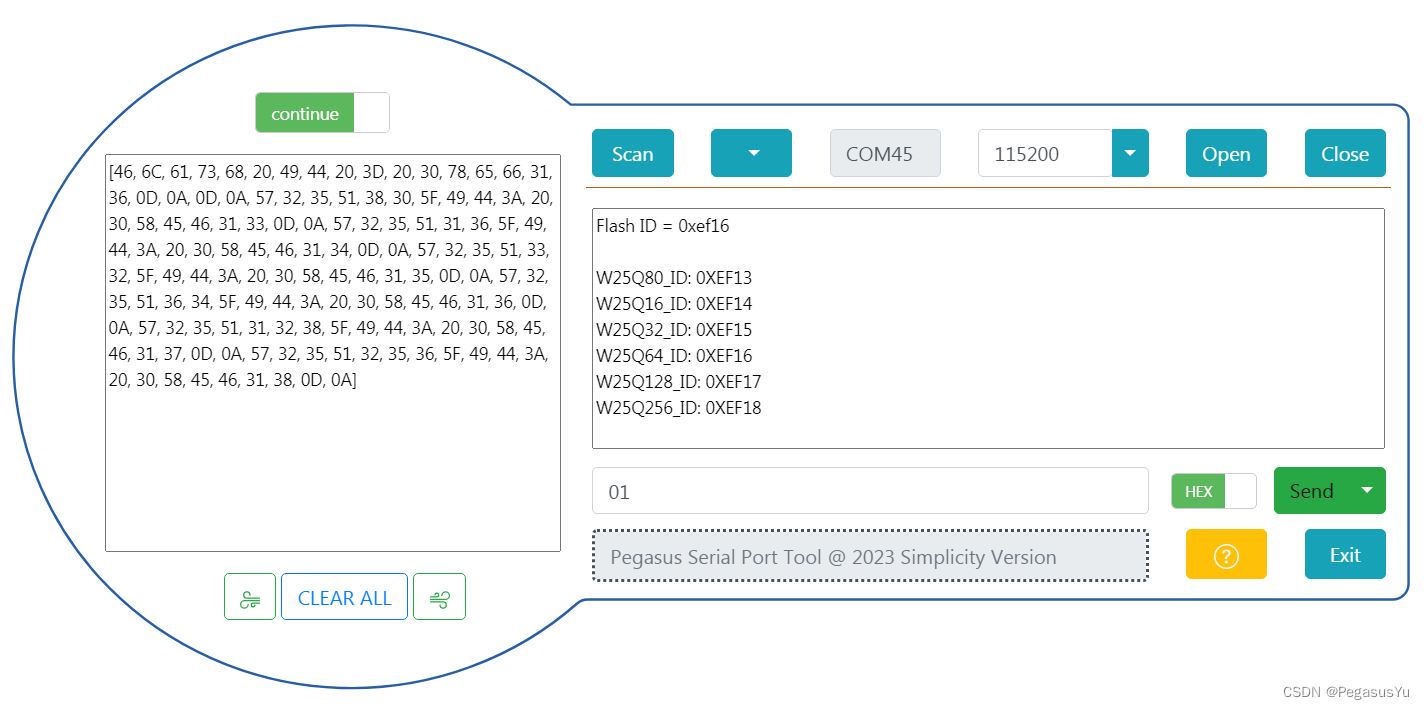
串口指令0x02测试效果如下:
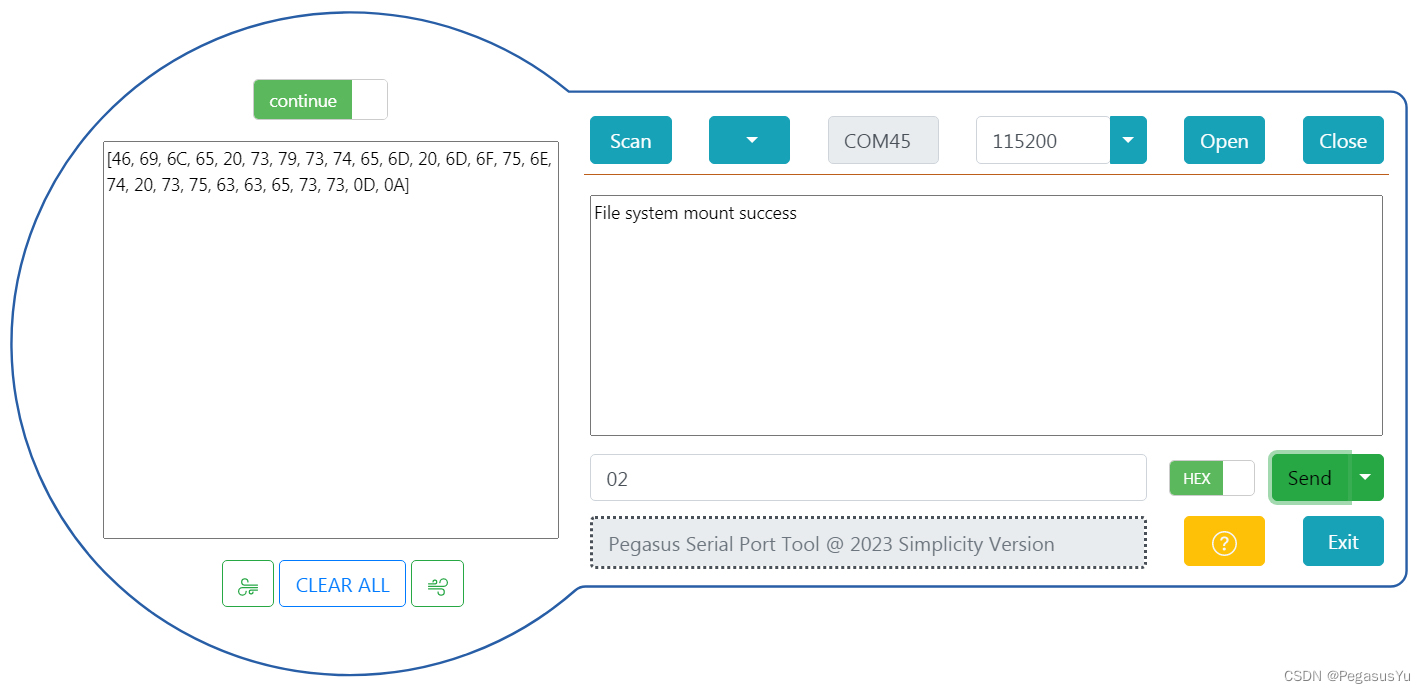
串口指令0x03测试效果如下:
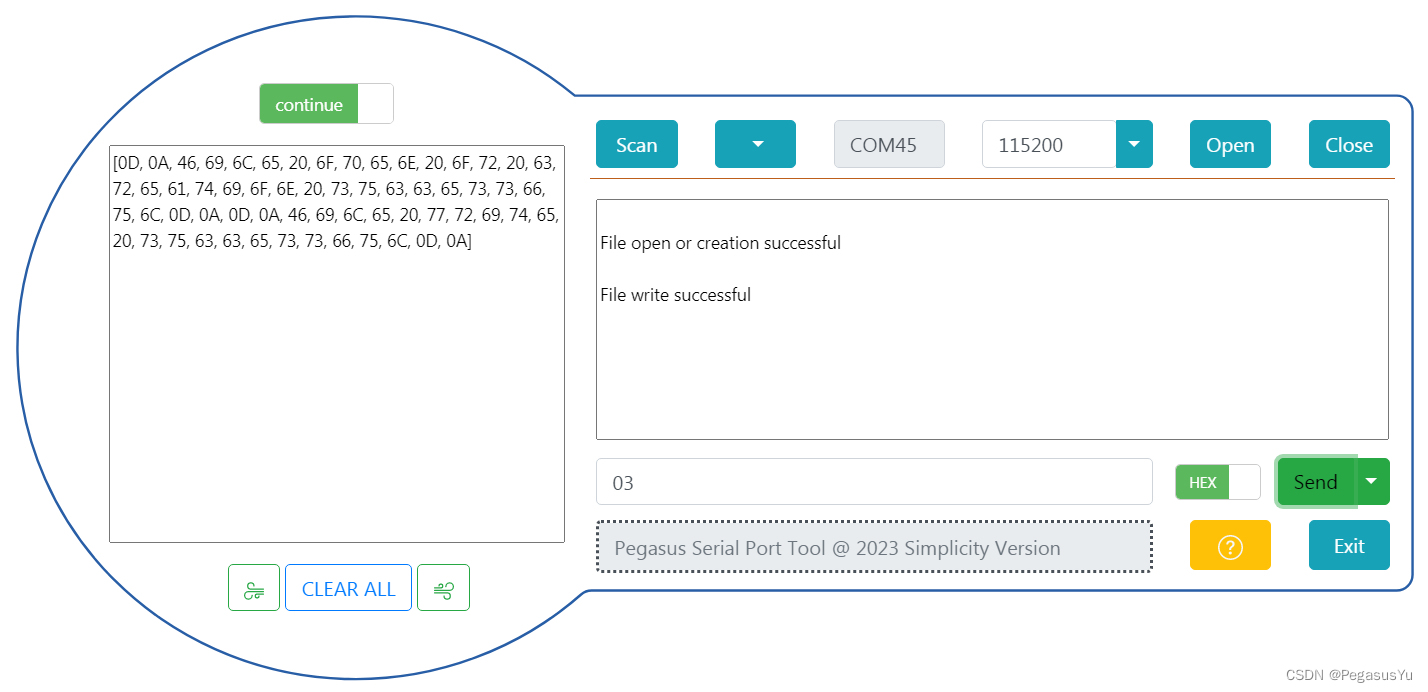
串口指令0x04测试效果如下:
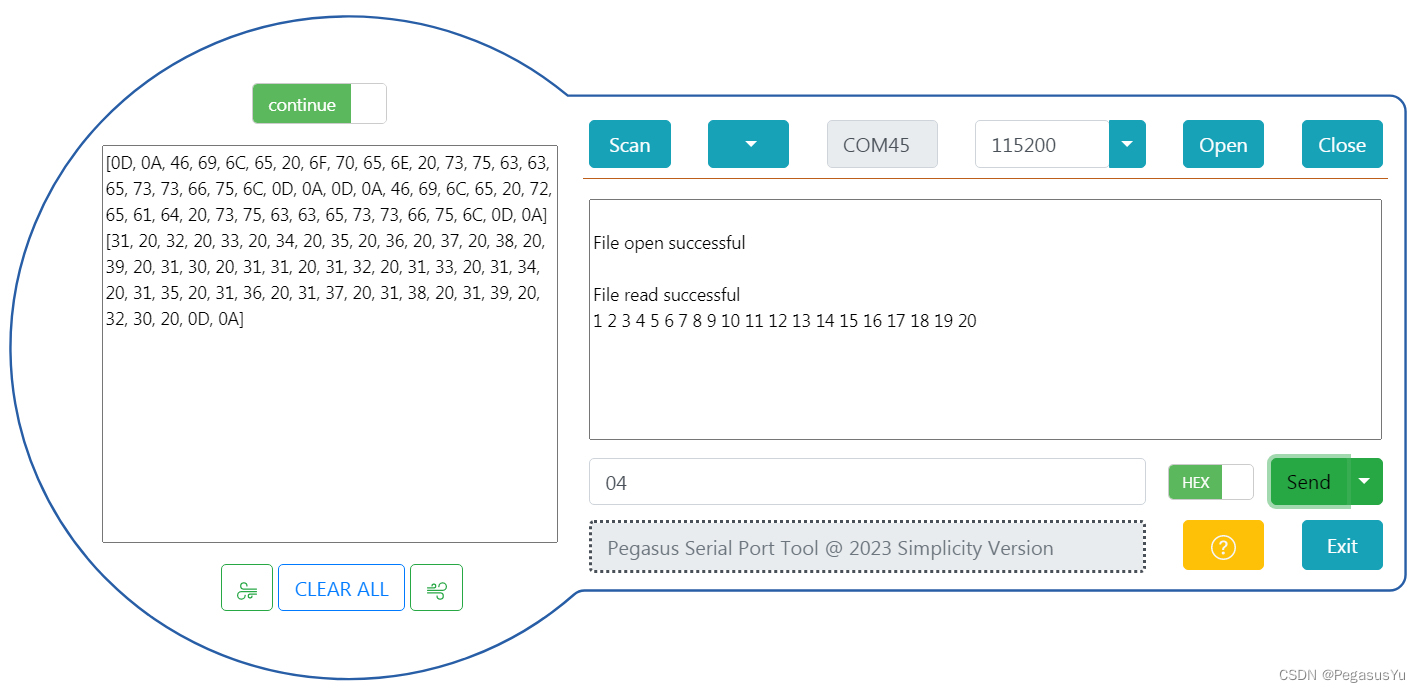
串口指令0x05测试效果如下:
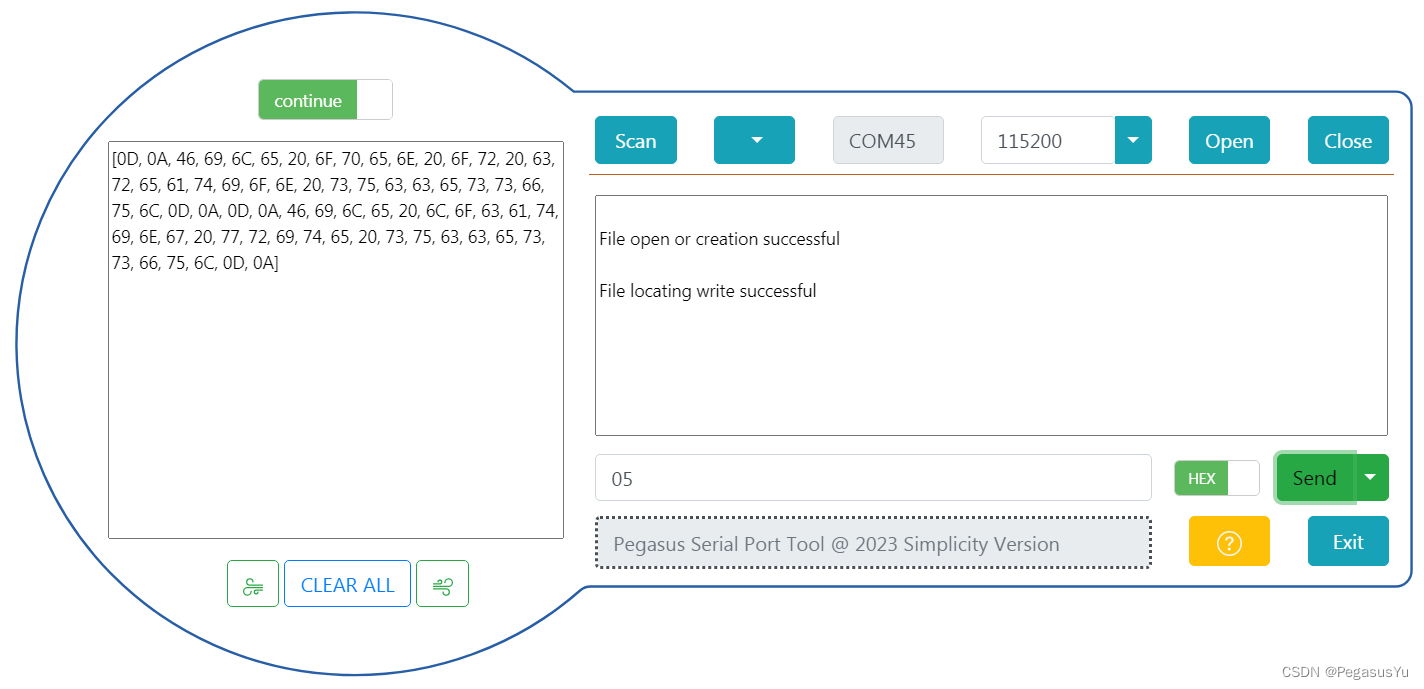
串口指令0x06测试效果如下:
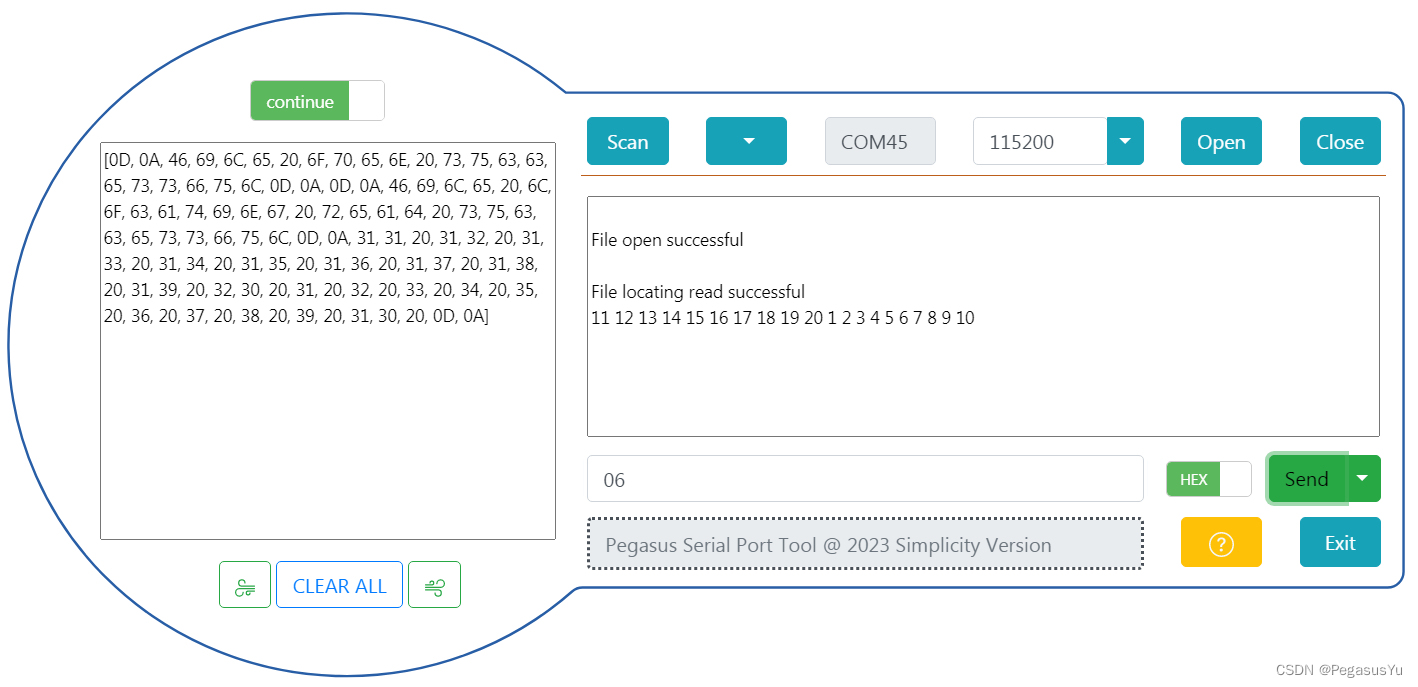
通过串口对FLASH对操作后,可以将STM32 USB接口连接到PC, 从PC端可以看到U盘接入,打开后可以看到通过串口建立和操作的文件:
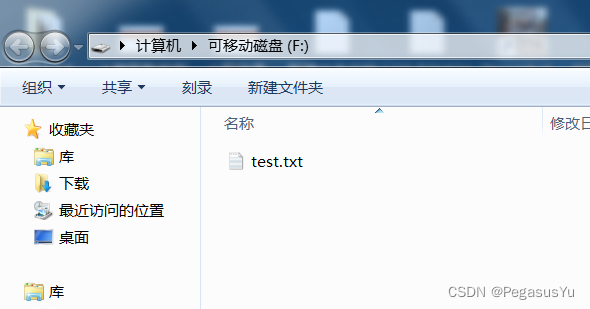

串口写入文件里的是1~20范围的16进制数据,这里显示为非常规字符,如果串口写入文件里的是英文字母对应的ASCII码16进制数据,文件里也就会显示为英文字母。
当通过U盘形式对文件进行操作后,同样也可以再通过串口对U盘形式操作过的文件访问操作。
STM32例程下载
STM32H750VBT6 模拟U盘桥接SPI总线FATS读写FLASH W25QXX例程下载
U盘模式升级方式
一种STM32升级方式为通过模拟U盘,从PC端将升级文件(.bin文件)存储进到外部FLASH里,STM32重新上电时识别标识从外部FLASH里将版本拷贝进到内部FLASH跳转空间,然后跳转执行。这是IAP升级的U盘接口常见方式,可以参考串口IAP升级过程,主要区别是版本数据获得方式不同。
一个不复杂的问题是为什么不从PC端直接写入.bin文件进到内部FLASH里,因为文件管理系统会占用额外的空间,也会导致文件放置首地址(跳转地址)易变,因此对MCU有限的内部FLASH空间而言不利资源使用。
–End–
相关文章:

STM32存储左右互搏 模拟U盘桥接SPI总线FATS读写FLASH W25QXX
STM32存储左右互搏 模拟U盘桥接SPI总线FATS读写FLASH W25QXX STM32的USB接口可以模拟成为U盘,通过FATS文件系统对连接的存储单元进行U盘方式的读写。 这里介绍STM32CUBEIDE开发平台HAL库模拟U盘桥接SPI总线FATS读写W25Q各型号FLASH的例程。 FLASH是常用的一种非易失…...
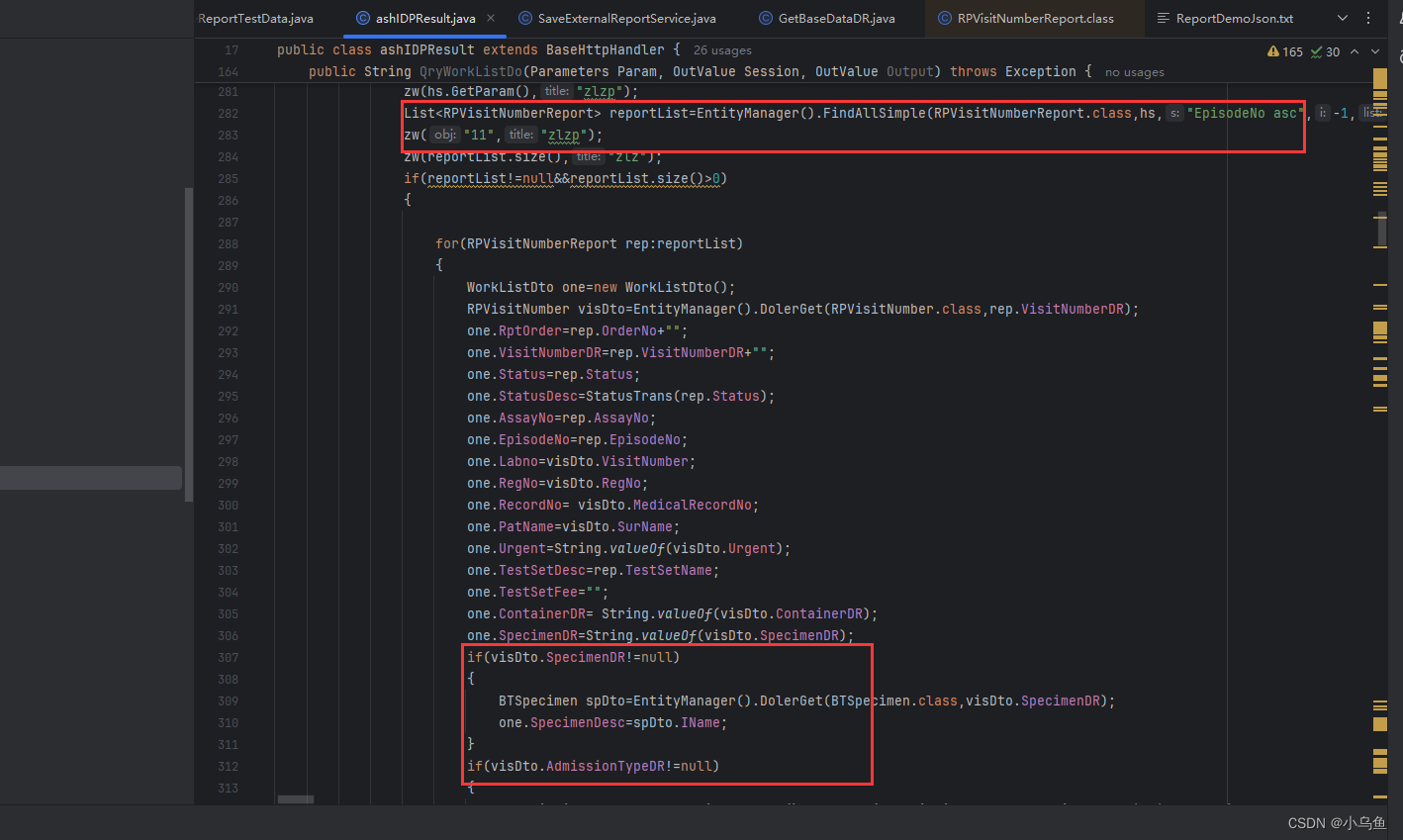
jrt从量变到质变
又是一个加班的周末,上周把台式机代码和数据库环境弄好了,这周进行大数据测试,直接把标本、标本医嘱、报告、报告结果、药敏结果等数据插入到1亿的规模,跑了一天一夜插入了5000多万个标本,后面接着补剩下的到一亿。 演…...

NLP主流大模型如GPT3/chatGPT/T5/PaLM/LLaMA/GLM的原理和差异有哪些-详细解读
自然语言处理(NLP)领域的多个大型语言模型(如GPT-3、ChatGPT、T5、PaLM、LLaMA和GLM)在结构和功能上有显著差异。以下是对这些模型的原理和差异的深入分析: GPT-3 (Generative Pre-trained Transformer 3) 虽然GPT-4…...

从MySQL到NoSQL:分析传统关系型数据库与NoSQL数据库的协同
引言 数据库是一个系统,用来管理和存储数据的地方。数据在数据库中以一种结构化的方式组织,这样能更容易地查询和处理数据。 关系型数据库是基于关系模型的数据库,它将数据存储在不同的表中,每个表都有各自的独一无二的主键。表与表之间通过共享的数据项相互关联。像MySQ…...

三、树和割集
文章目录 1、树1.1 树的定义1.2 树的性质1.3 极小连通图1.4 树的中心1.5 生成树1.5.1 最小生成树 2、 割点和桥THE END 1、树 1.1 树的定义 \qquad 定义: 一个连通的无圈的图称为树。 \qquad 只有一个顶点的树叫做平凡树。 \qquad 树中度为1的节点称为叶子结点。…...

泛型中<>和()中的类型
尖括号 < > 中的类型参数定义了一组可以被替换的类型占位符,而圆括号 (...) 内的类型使用则是这些类型参数的具体应用场景,展示了这些类型变量如何参与到函数的参数和返回值类型定义中去。这样设计既保证了代码的灵活性,又保持了类型安…...

spark mllib 特征学习笔记 (一)
PySpark MLlib 特征处理详解 PySpark MLlib 提供了丰富的特征处理工具,帮助我们进行特征提取、转换和选择。以下是 PySpark MLlib 中常用的特征处理类及其简要介绍。 1. Binarizer Binarizer 是将连续特征二值化的转换器。 from pyspark.ml.feature import Bina…...

SQLite 日期 时间
SQLite 日期 & 时间 SQLite 是一种轻量级的数据库管理系统,广泛用于各种应用程序中。它支持标准的 SQL 语法,包括对日期和时间的处理。在 SQLite 中,日期和时间可以通过几种不同的方式来存储和操作。 日期和时间数据类型 SQLite 使用 …...

飞书API 2-1:如何通过 API 创建文件夹?
本文探讨如何通过飞书的 API 来创建文件夹。通过 API 创建的文件夹,一般是放在共享空间,如果要放在个人空间,建议手动创建。 查看 API 文档 API 路径,可在飞书开放平台的服务端 API,依次查找云文档>云空间>文件…...
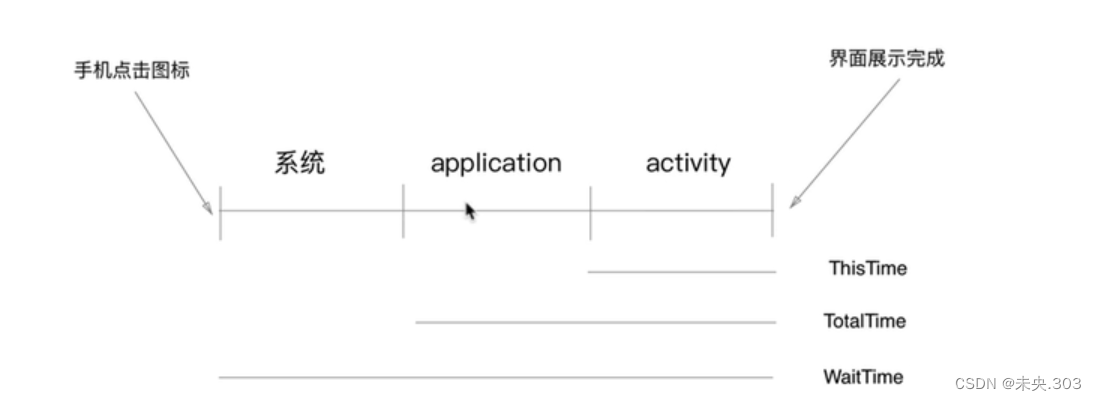
【APP移动端自动化测试】第一节.环境配置和adb调试工具
文章目录 前言一、Java环境搭建二、AndroidSDK环境搭建三、Android模拟器安装四、adb调试工具基本介绍 4.1 adb构成和基本原理 4.2 adb获取包名,界面名 4.3 adb文件传输 4.4 adb获取app启动时间 4.5 adb获取手机日志 4.6 adb其他有关…...

Kotlin 协程:从基础概念到开发实践
前言 上一篇文章 深入理解Android多线程开发:场景应用与解决方案解析 针对Android开发中的多线程应用场景和相应的解决方案做了一个梳理。 总结出了Android开发中多线程编程的几个重要点: 资源复用和优化切线程任务编排并结合示例说明了Kotlin协程在处理上述问题时的优势。 …...

IPNV6
特征——升级点: 1、全球单播地址 ----IPV4地址下的公有地址 V6下没 nat 2、可聚合性 (IANA组织对全球的地址进行合理分配) 3、多宿主——一个物理接口可以同时拥有多个不同网段的IPV6地址;但不同接口不能在同一网段 4、自动配置 1ÿ…...

C++并发之锁(std::lock_guard,std::unique_lock)
目录 1 概述2 使用实例3 接口使用3.1 lock_guard3.2 adopt_lock3.3 defer_lock3.4 try_to_lock3.5 try_lock3.6 release3.7 lock3.8 call_one1 概述 锁保护是通过使互斥对象始终处于锁定状态来管理互斥对象的对象。。 在构造时,互斥对象被调用线程锁定,在析构时,互斥被解…...
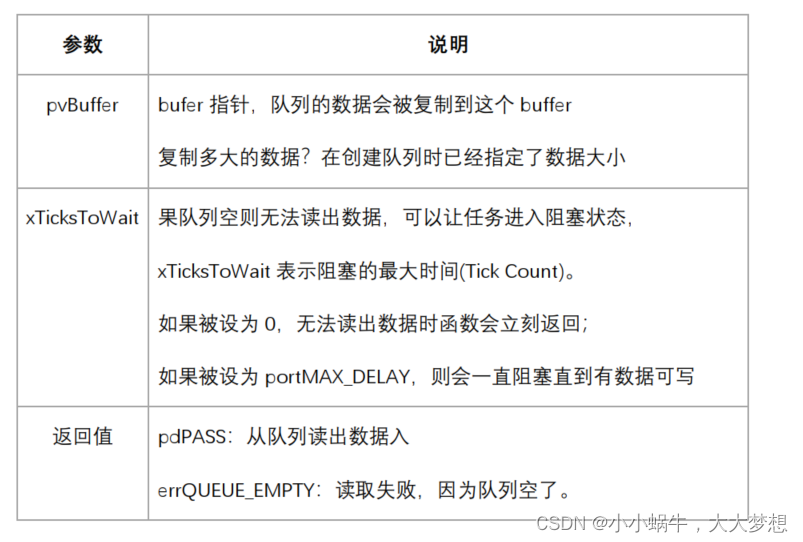
FreeRTOS队列(queue)
队列(queue)可以用于"任务到任务"、 "任务到中断"、 "中断到任务"直接传输信息。 1、队列的特性 1、1常规操作 队列的简化操如下图所示,从此图可知: 队列中可以包含若干数据:队列中有若干项,这…...

Azure数据分析Power BI
Azure数据分析Power BI 一、Power BI简介二、Power BI 如何匹配角色三、Power BI 构建基块四、使用 Power BI 服务一、Power BI简介 Microsoft Power BI 是一系列的软件服务、应用和连接器,这些软件服务、应用和连接器协同工作,将不相关的数据源转化为合乎逻辑、视觉上逼真的…...

将 Python3 程序打包成 APK 并运行在 ARM 的 Android 系统中
作为一个开发者,我们经常需要将我们的 Python 程序部署到移动端,以便更好地服务于用户。然而,直接在 Android 系统上运行 Python 程序却存在一定的挑战,因为 Android 系统默认不支持 Python。这篇文章将介绍如何将 Python3 程序打…...
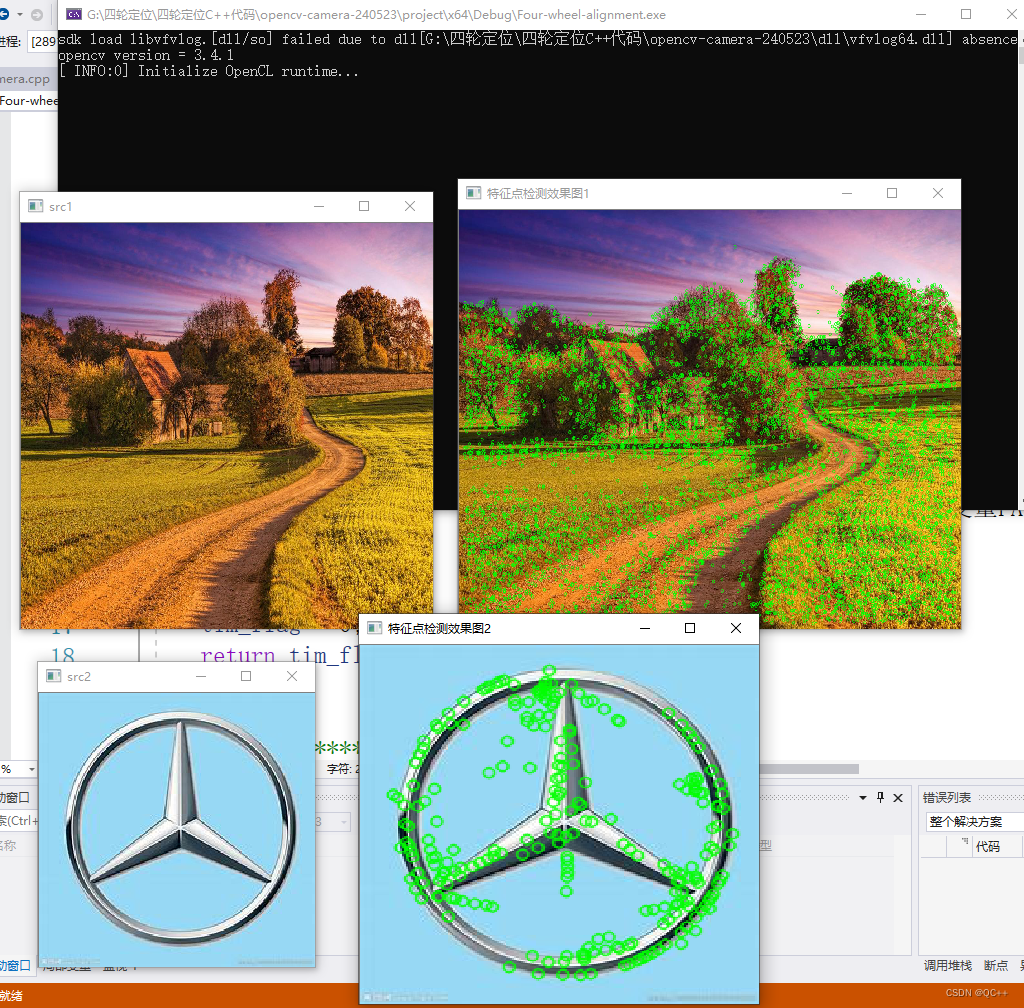
学习记录:VS2019+OpenCV3.4.1实现SURF库函数的调用
最近在学习opencv的使用,在参照书籍《OpenCV3编程入门》实现SURF时遇到不少问题,下面做归纳总结。 错误 LNK2019 无法解析的外部符号 “public: static struct cv::Ptr __cdecl cv::xfeatures2d::SURF::create(double,int,int,bool,bool)” (?createSUR…...
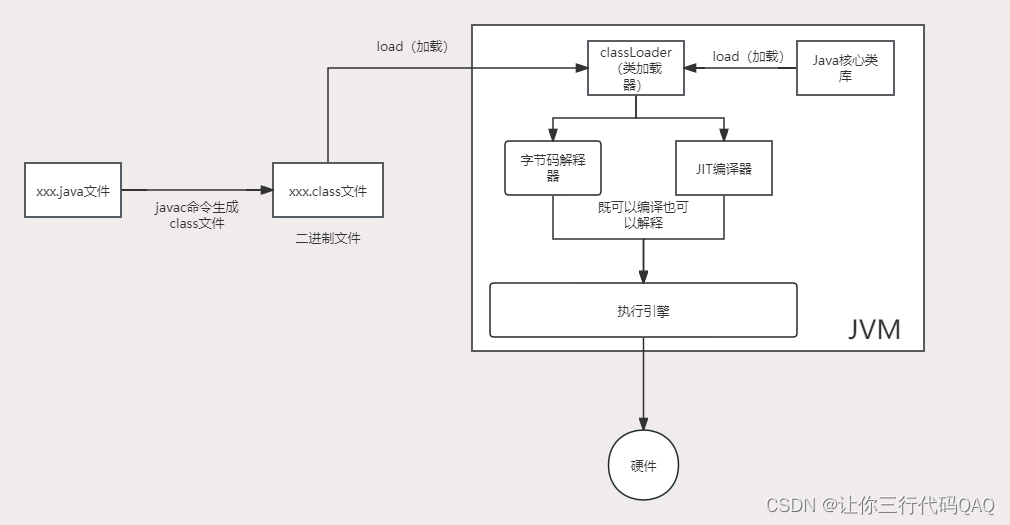
JVM-基础知识
JVM-基础知识 什么是JVM JVM是一种跨语言的平台,任何语言只要能编译成.class文件都可以被JVM运行。JVM只和.class文件有关系,和Java语言没关系。JVM是一种虚拟机规范。 java文件是如何交给JVM执行的 JVM的常见实现 HostStop:Oracle官方另外还有IBM的J9、…...

保密工作应党而生、伴党而行、为党而兴
1.(C )工作应党而生、伴党而行、为党而兴,始终是党和国家的一项重要工作。 A. 农业 B. 国防 C. 保密 D. 文化 2.机关、单位对所产生的国家秘密事项,应当按照国家秘密及其密级的具体范围的规定确定密级,同时确定&#x…...

docker login 报错: http: server gave HTTP response to HTTPS client
环境: 自建 Harbor、Docker 1. 问题分析 # 命令,这里用的是 IP,可以为域名 docker login -u test 172.16.51.182:31120 # 输入密码 Password:# 报错如下: Error response from daemon: Get "https://172.16.51.182:31120/…...

「C系列」C 文件读写
文章目录 一、C 文件读写1. 打开文件2. 写入文件3. 读取文件4. 关闭文件5. 文件读写模式6. 错误处理 二、常见问题1. 文件打开失败2. 文件读写错误3. 文件读写位置4. 缓冲区刷新 三、相关链接 一、C 文件读写 在C语言中,文件读写是通过一系列的标准库函数来完成的&…...

编程中的cos:深度解析与应用探索
编程中的cos:深度解析与应用探索 在编程的广阔天地中,cos这一数学概念扮演着举足轻重的角色。它不仅是数学函数库中的基础元素,更是图形渲染、科学计算以及数据处理等多个领域的核心工具。本文将从四个方面、五个方面、六个方面和七个方面&a…...

计算机毕业设计hadoop+spark+hive知识图谱酒店推荐系统 酒店数据分析可视化大屏 酒店爬虫 高德地图API 酒店预测系统 大数据毕业设计
流程: 1.Python爬取去哪儿网全站旅游数据约10万,存入mysql; 2.使用pandasnumpy/hadoopmapreduce对mysql中旅游数据进行数据清洗,使用高德API计算地理信息,最终转为.csv文件上传hdfs; 3.hive建库建表导入.csv文件作为数据集&#x…...

简单谈谈云服务器私网IP的存在意义及优势
云服务器是基于虚拟化技术的计算资源,可以在云平台上灵活创建和管理。为了满足不同用户的需求,云服务提供商在云服务器上分配了两种类型的IP地址:公网IP和私网IP。其中,私网IP是指在局域网内使用的内部IP地址,无法通过…...
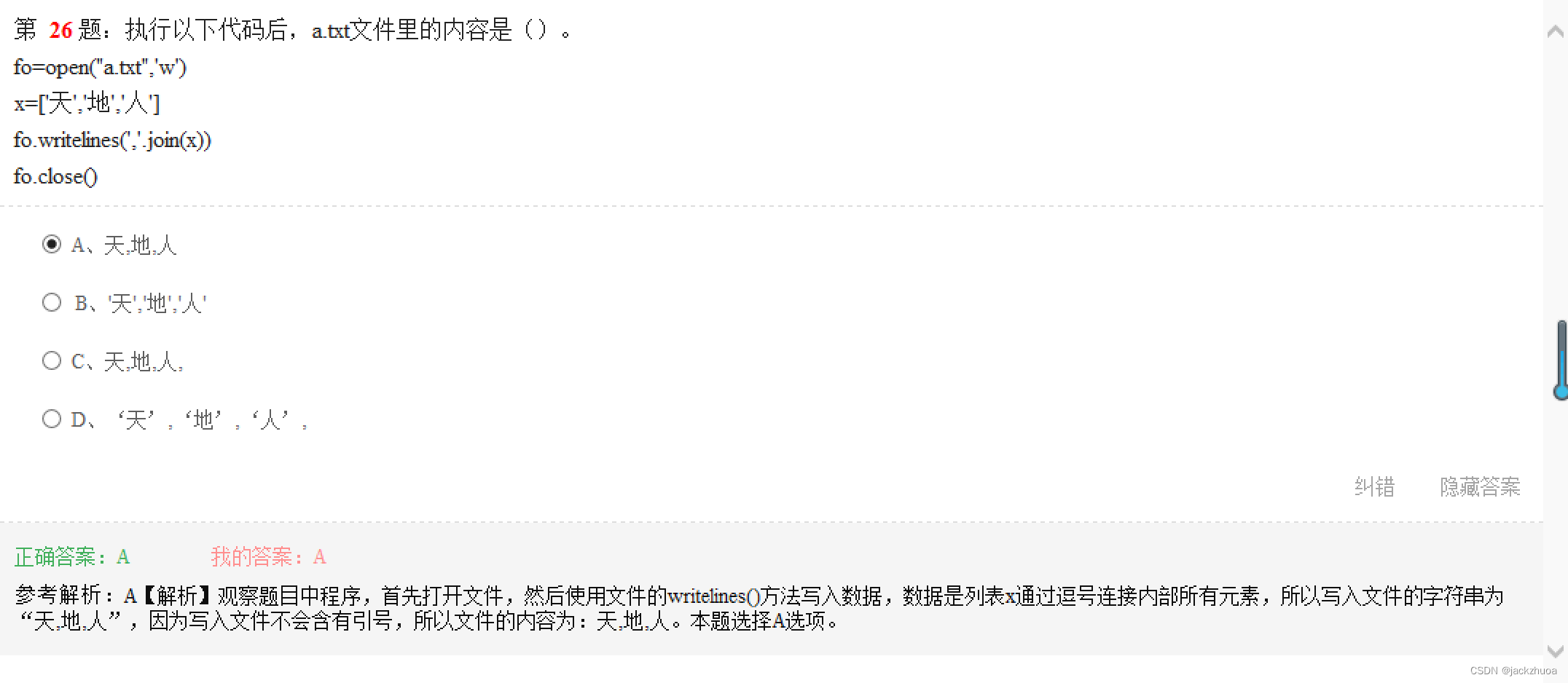
python错题(2)
、...
禁止methtype联网
mathtype断网_如何禁止mathtype联网-CSDN博客https://blog.csdn.net/qq_41060221/article/details/128144783...

【iOS】UI学习——cell的复用及自定义cell
目录 前言cell的复用手动(非注册)自动(注册) 自定义cell总结 前言 Cell复用和自定义Cell是在开发iOS应用时常见的一种优化技巧和定制需求。 Cell复用是UITableView或UICollectionView的一个重要优化机制。当用户滚动这些视图时…...

【详细介绍下PostgreSQL】
🌈个人主页: 程序员不想敲代码啊 🏆CSDN优质创作者,CSDN实力新星,CSDN博客专家 👍点赞⭐评论⭐收藏 🤝希望本文对您有所裨益,如有不足之处,欢迎在评论区提出指正,让我们共…...
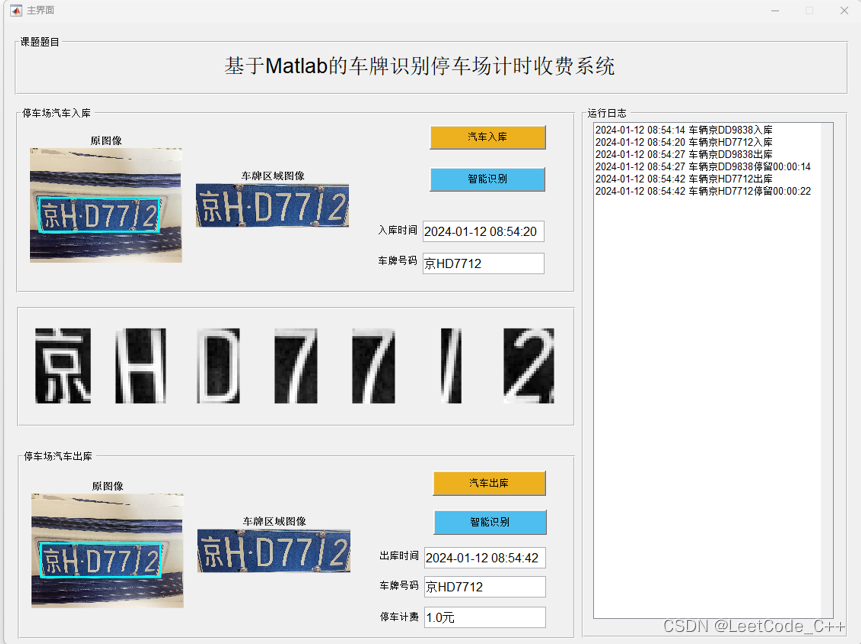
基于Matlab停车场车牌识别计时计费管理系统 【W2】
简介 停车场车牌识别计时计费管理系统在现代城市管理中具有重要意义。随着城市化进程的加快和车辆数量的增加,传统的人工管理停车场的方式已经难以满足效率和精确度的要求。因此引入车牌识别技术的自动化管理系统成为一种趋势和解决方案。 背景意义 提升管理效率&a…...

码住!详解时序数据库不同分类与性能对比
加速发展中的时序数据库,基于不同架构,最流行的类别是? 作为管理工业场景时序数据的新兴数据库品类,时序数据库凭借着对海量时序数据的高效存储、高可扩展性、时序分析计算等特性,一跃成为物联网时代工业领域颇受欢迎的…...

即墨网站建设公司/武汉seo招聘网
text...........................

网上申请注册公司应该怎么办理/佛山市seo推广联系方式
linux下php增加openssl.so模块切换到php安装目录的etx/openssl目录cd /home/tao/soft/php-5.2.13/ext/opensslopenssl目录下有个config.w32和config0.m4,把config0.m4改名为config.m4(原因不解释)mv config0.m4 config.m4$PHP_PREFIX/bin/phpize或直接/usr/local/ph…...

网站建设营销话术/青岛seo代理计费
2019独角兽企业重金招聘Python工程师标准>>> 根据《深入浅出设计模式(C#/Java版)》所述, Strategy模式的应用场景是:1. 多个类的分别只是在于行为不同2. 你需要对行为的算法做很多变动3. 客户不知道算法要使用的数据 Template Method模式的应用场景是:1. 你想将相同…...

网络维护好学吗/网站页面优化方案
GotW #04 Class Mechanics 著者:Herb Sutter 翻译:kingofark [声明]:本文内容取自www.gotw.ca网站上的Guru of the Week栏目,其著作权归原著者本人所有。译者kingofark在未经原著者本人同意的情况下翻译本文。本翻译内容仅供…...

东城手机网站建设/app拉新推广怎么做
在调研BFF的过程中,看到蚂蚁金服自研的BFF的开发框架BFF Chair是基于Egg.js开发的。BFF Chair没有开源,但是Egg.js已经开源了,如果需要引入BFF,需要基于Egg.js的基础上开发自己的BFF开发框架。 1 Egg.js是什么 Egg是一个为了开发…...

网站的用户体验/seo网站快速整站优化技术
框架之开发中的版本传递问题 一、通过get传参的方式 1.自定义接收参数类 class ParamVersion(object):def determine_version(self, request, *args, **kwargs):version request.query_params.get(version)return versionclass UsersView(APIView):versioning_class Param…...
